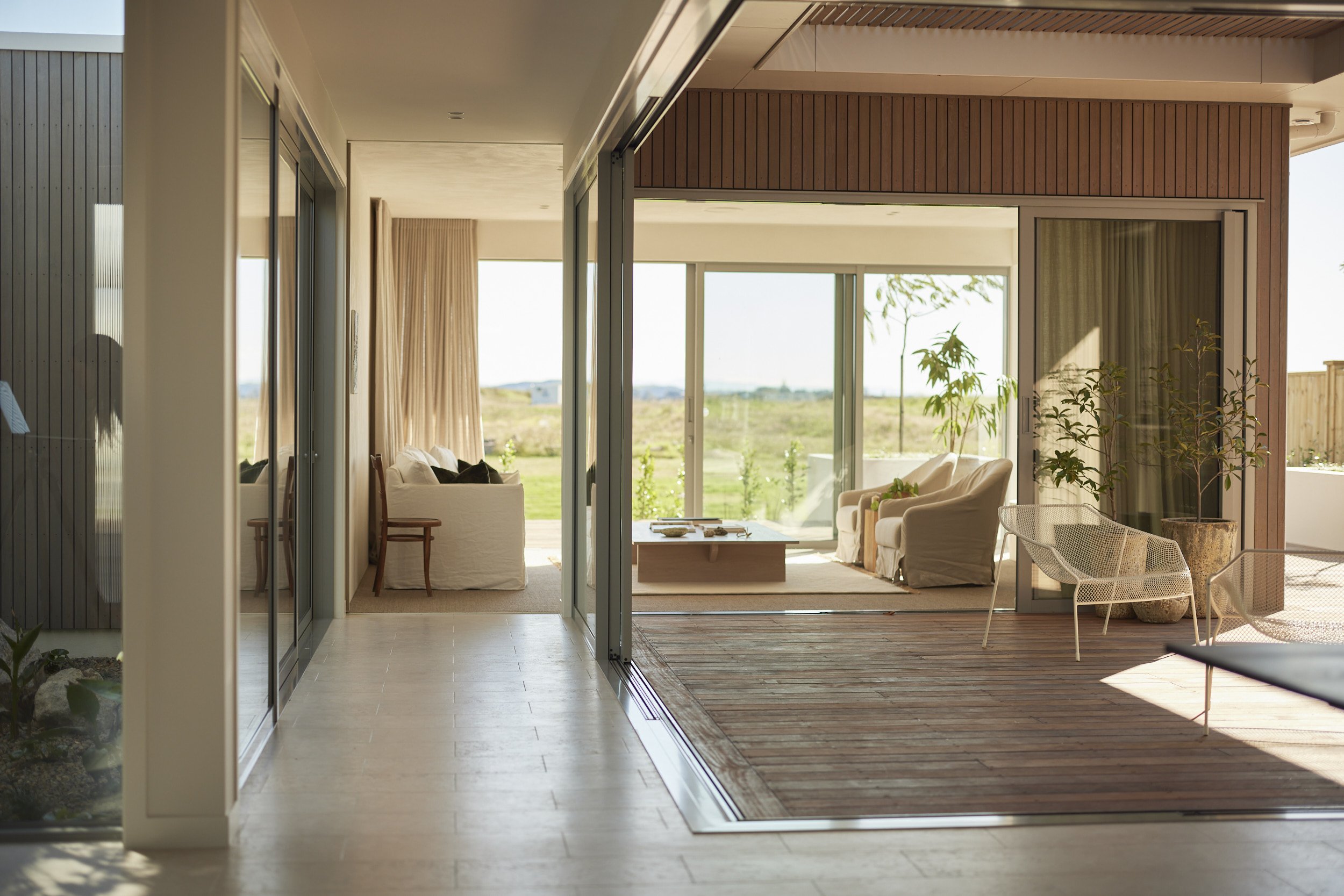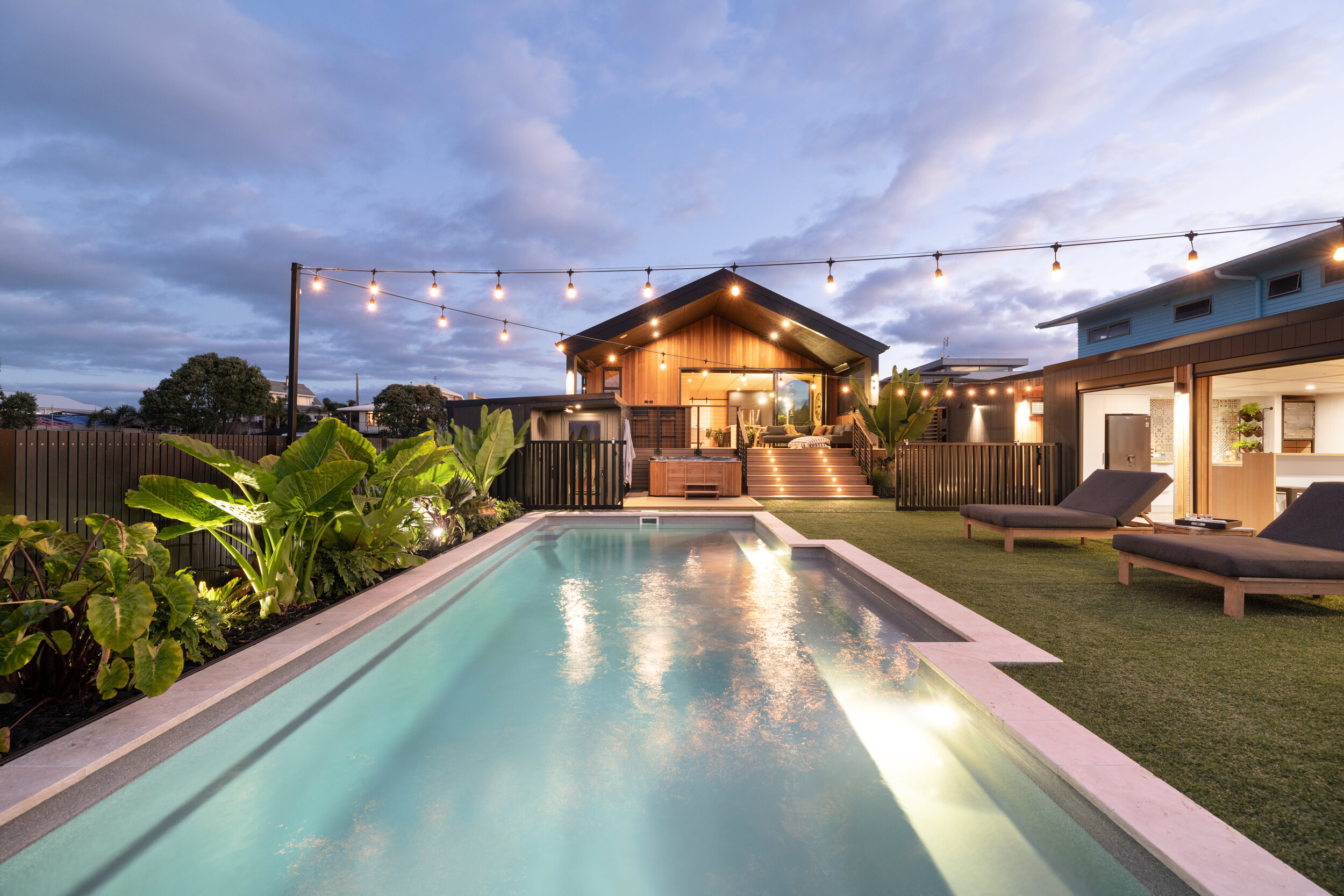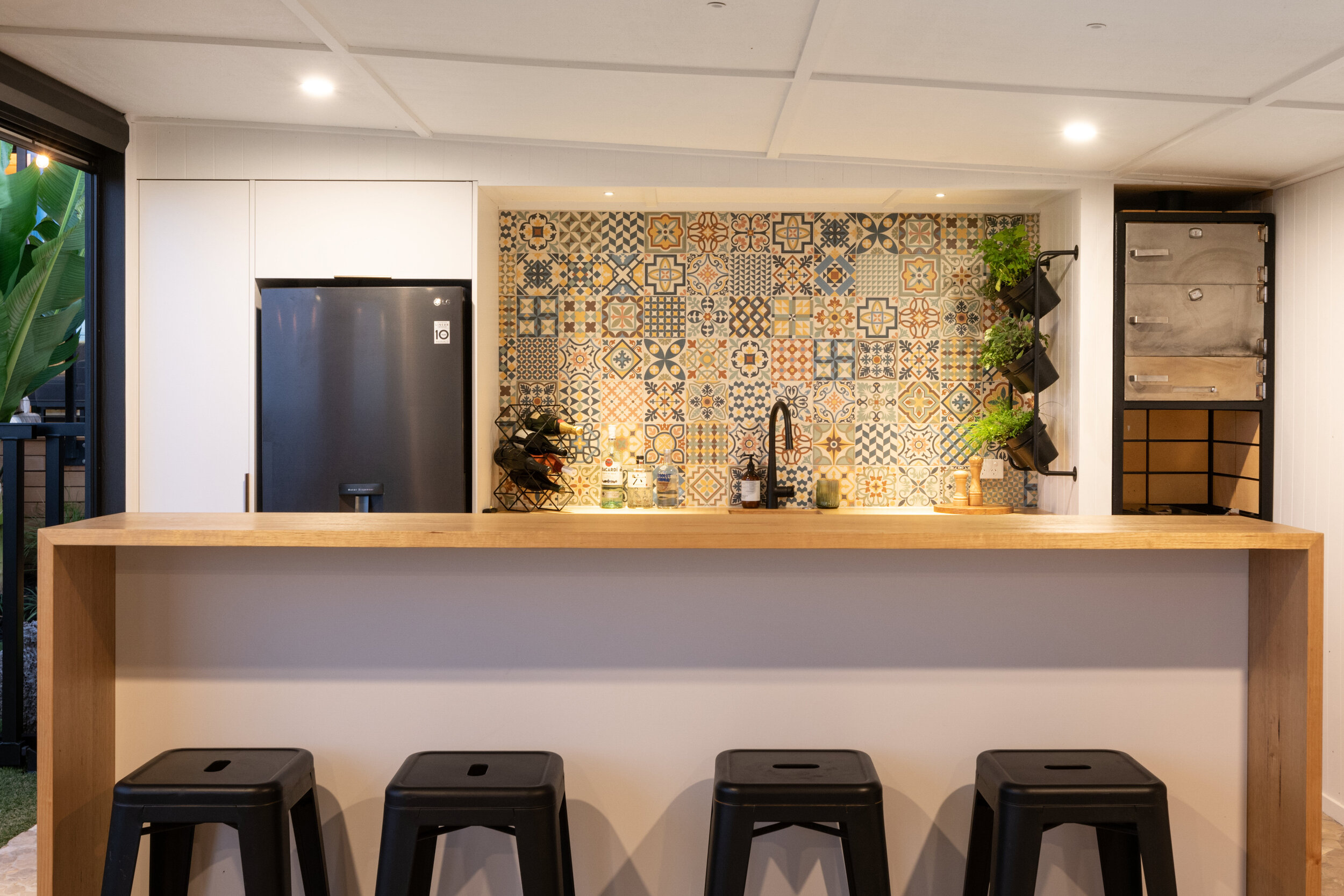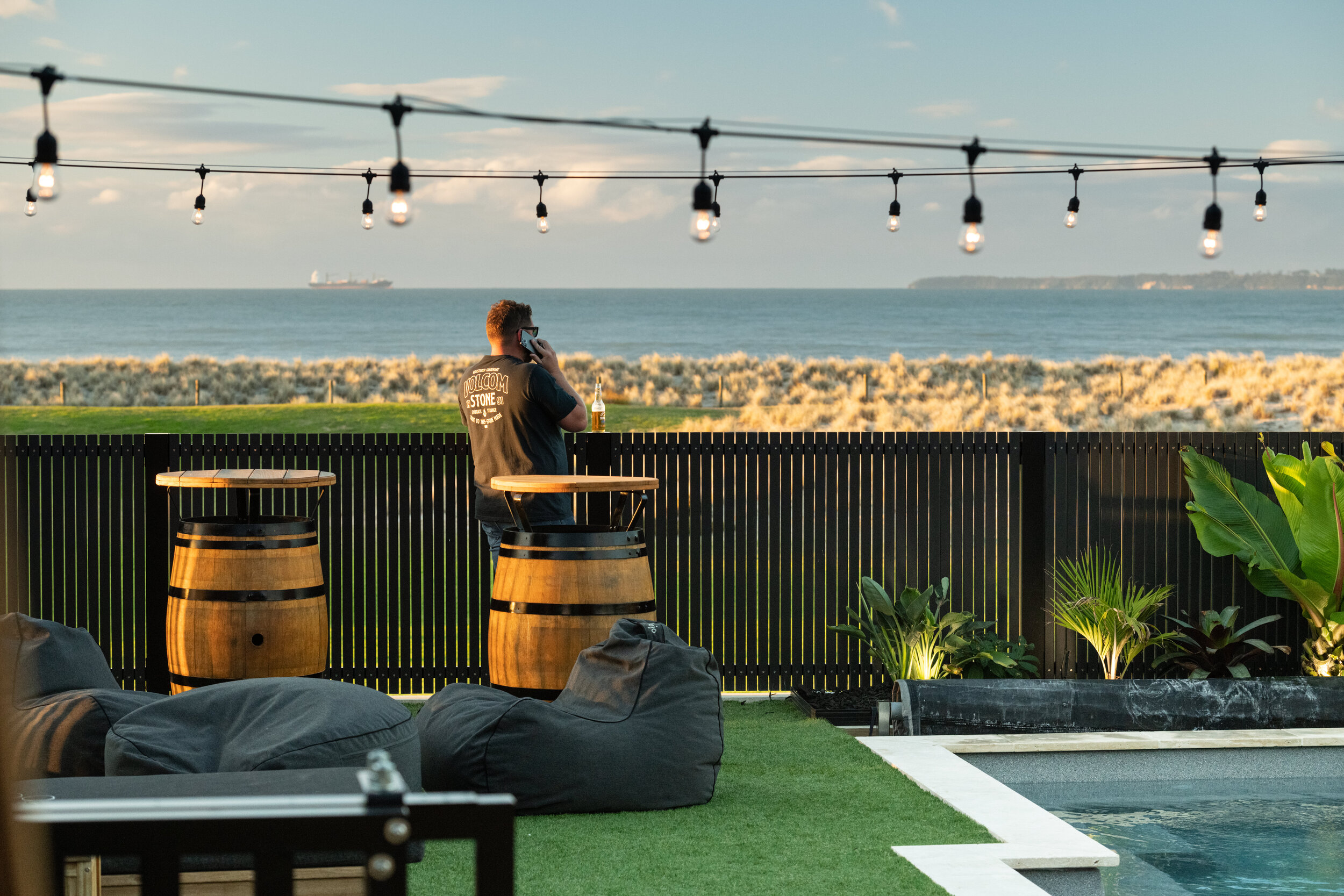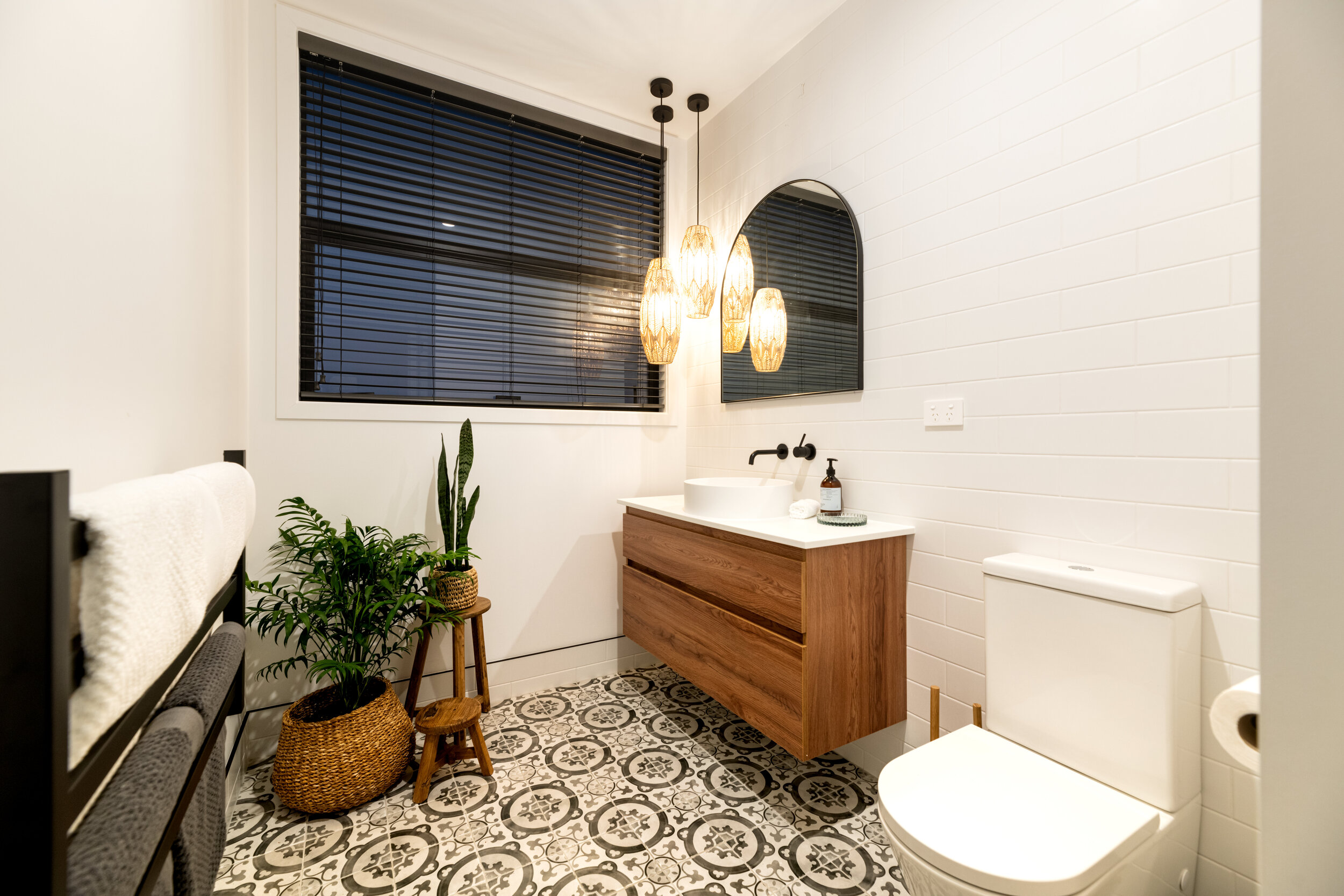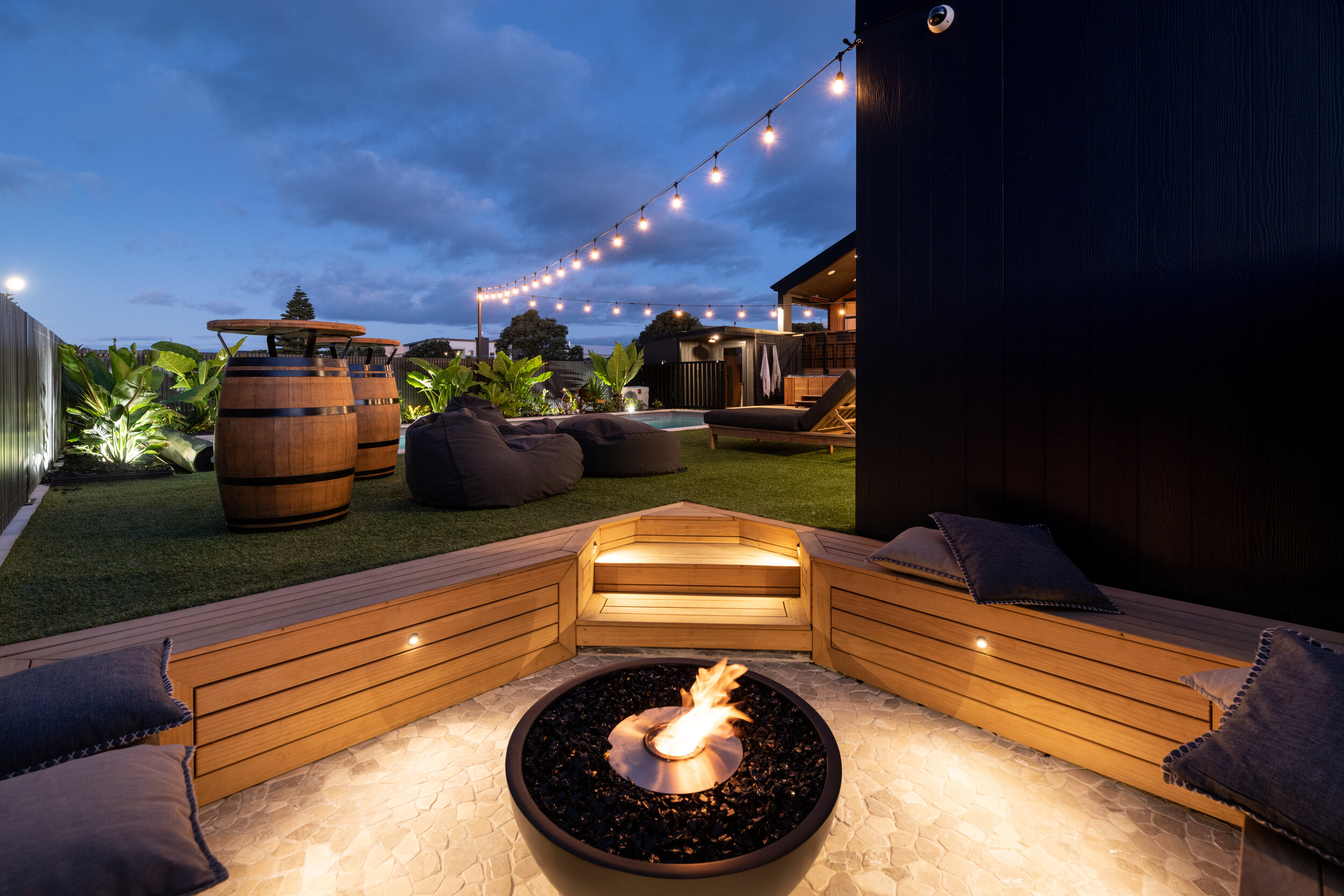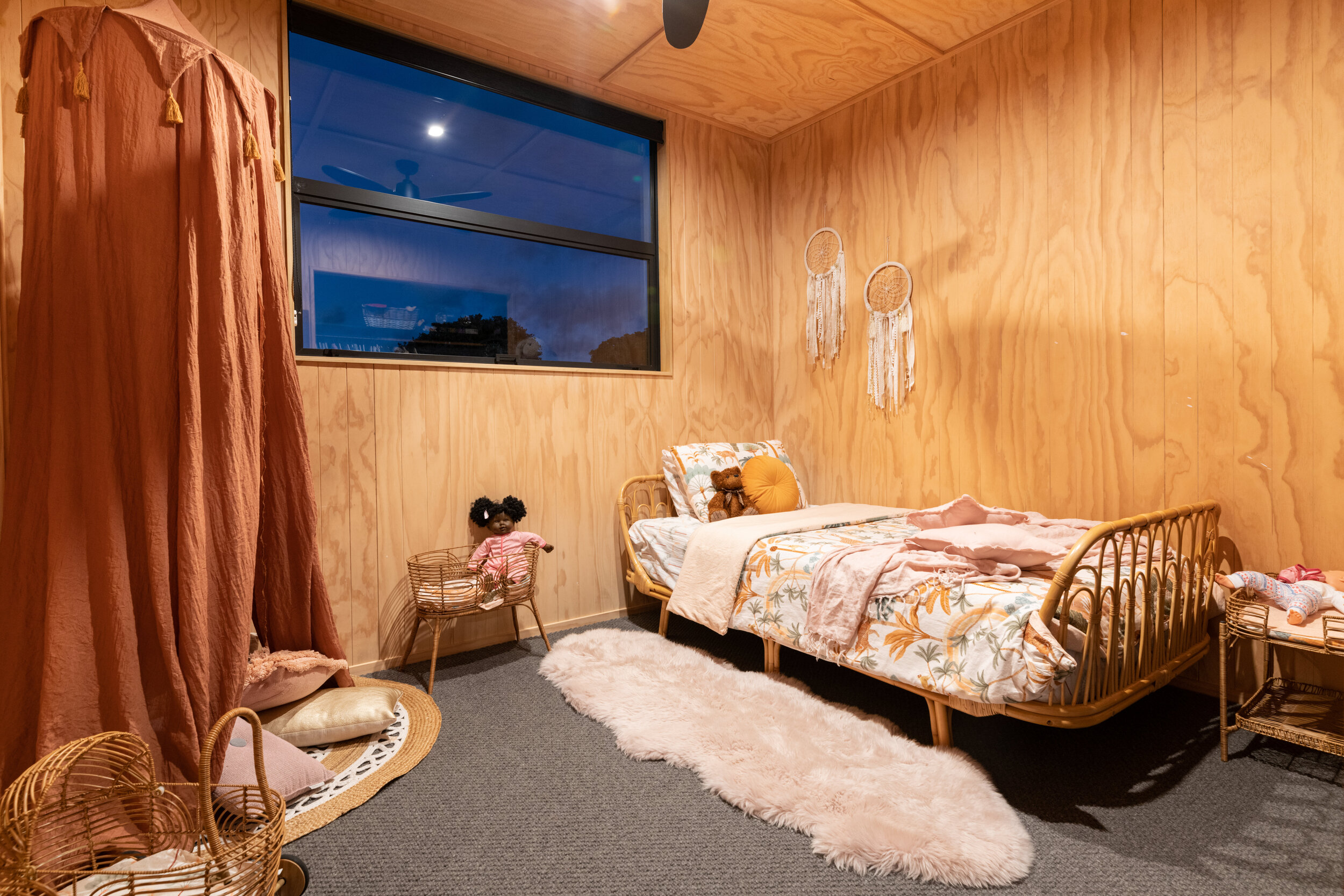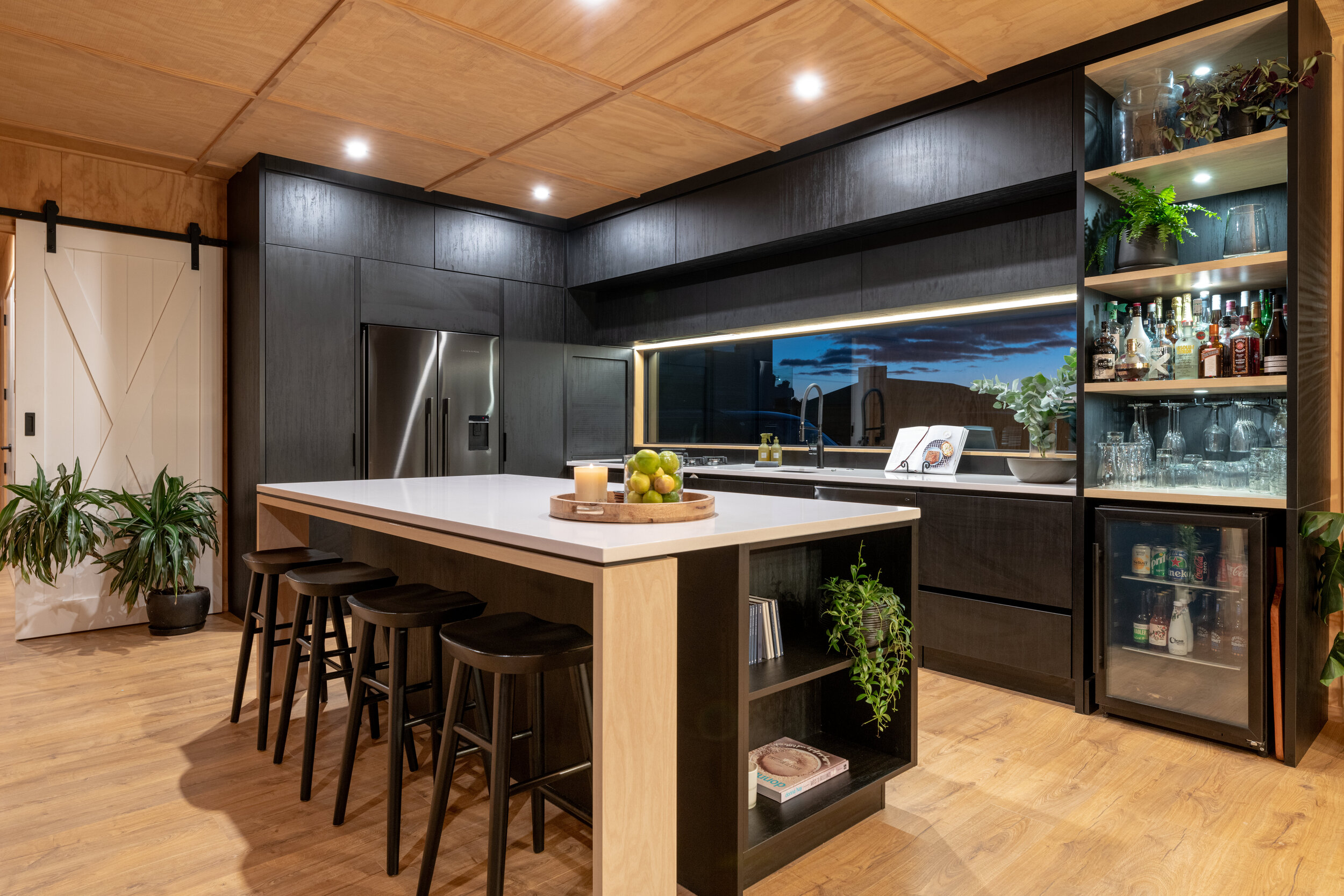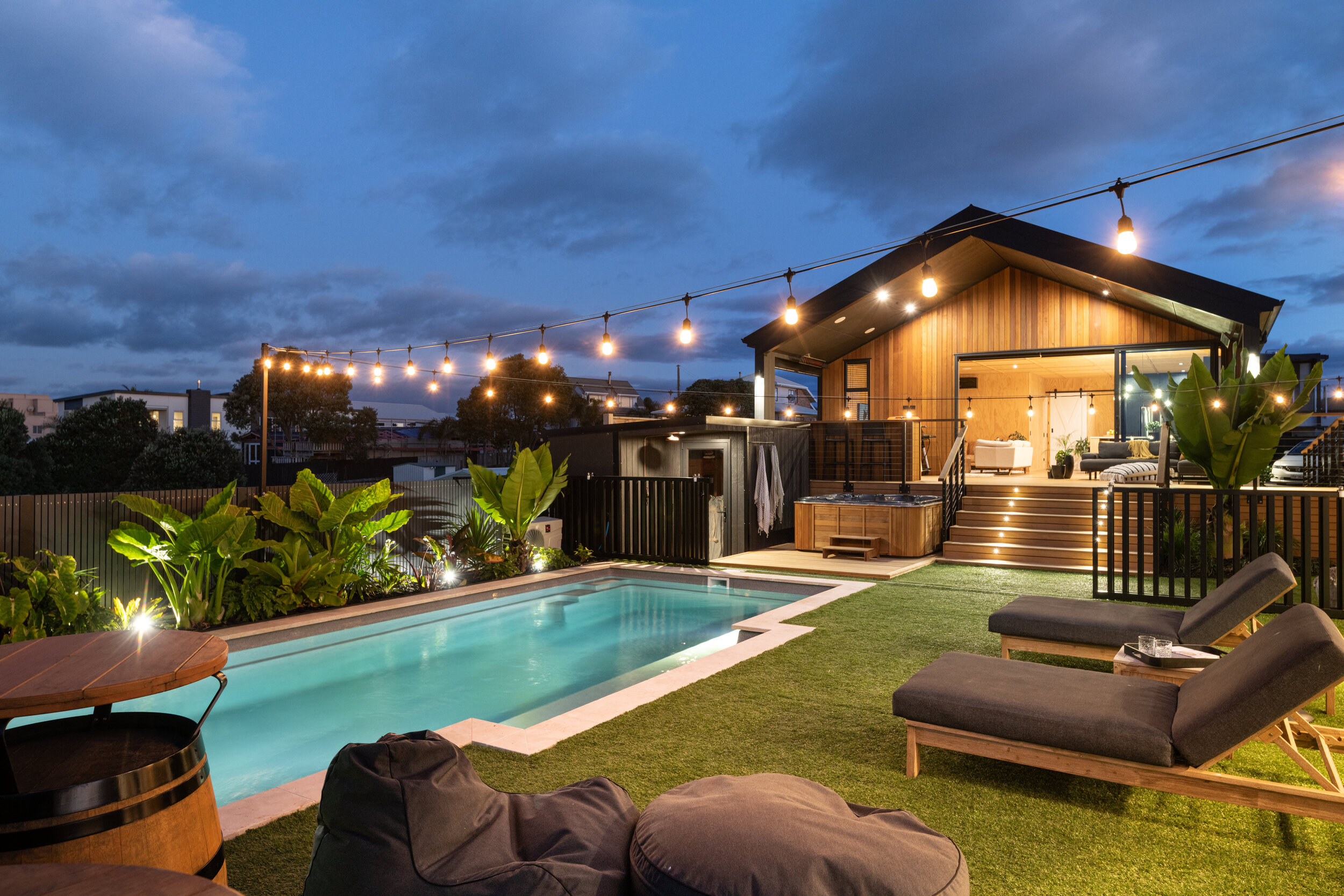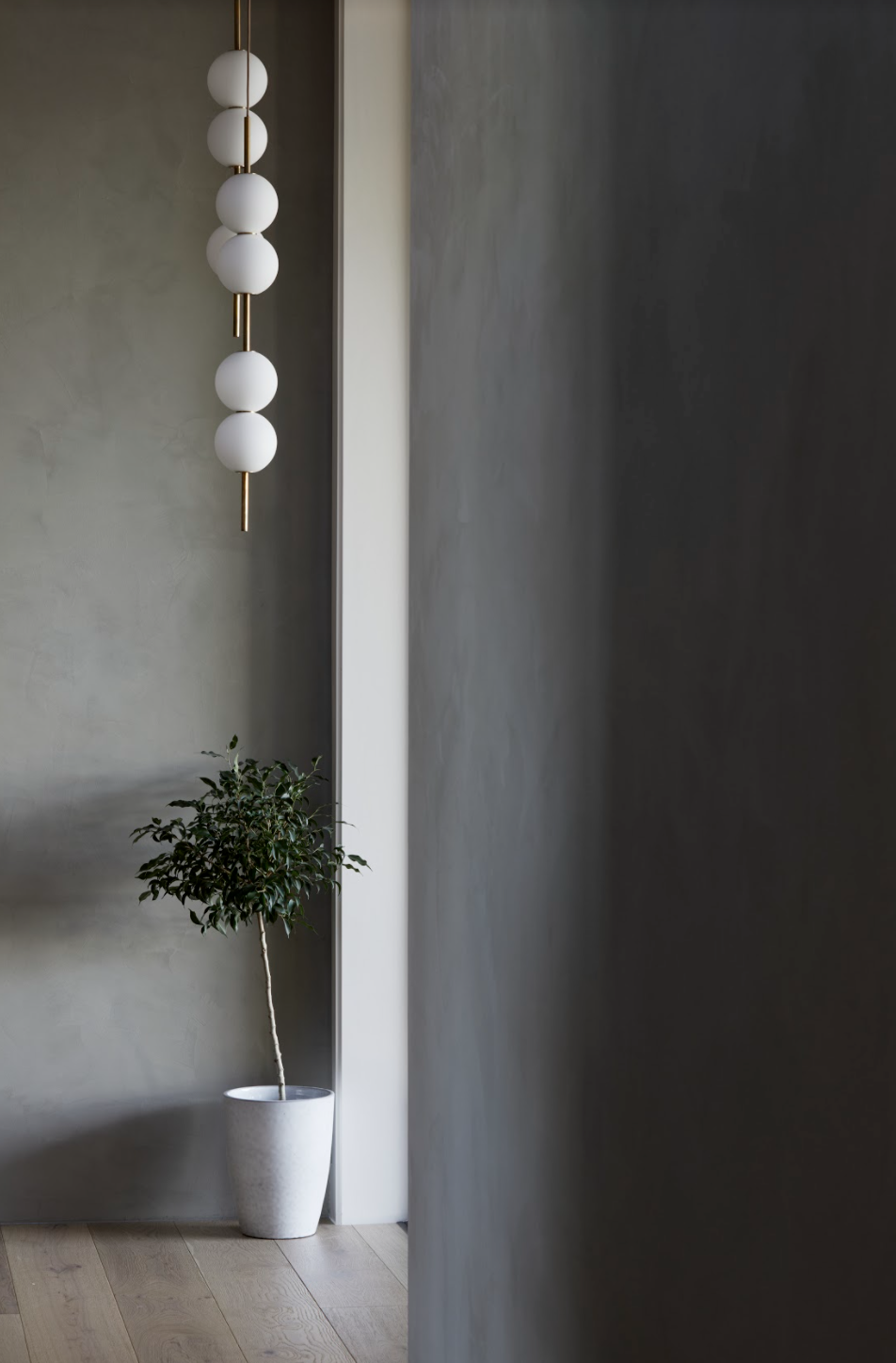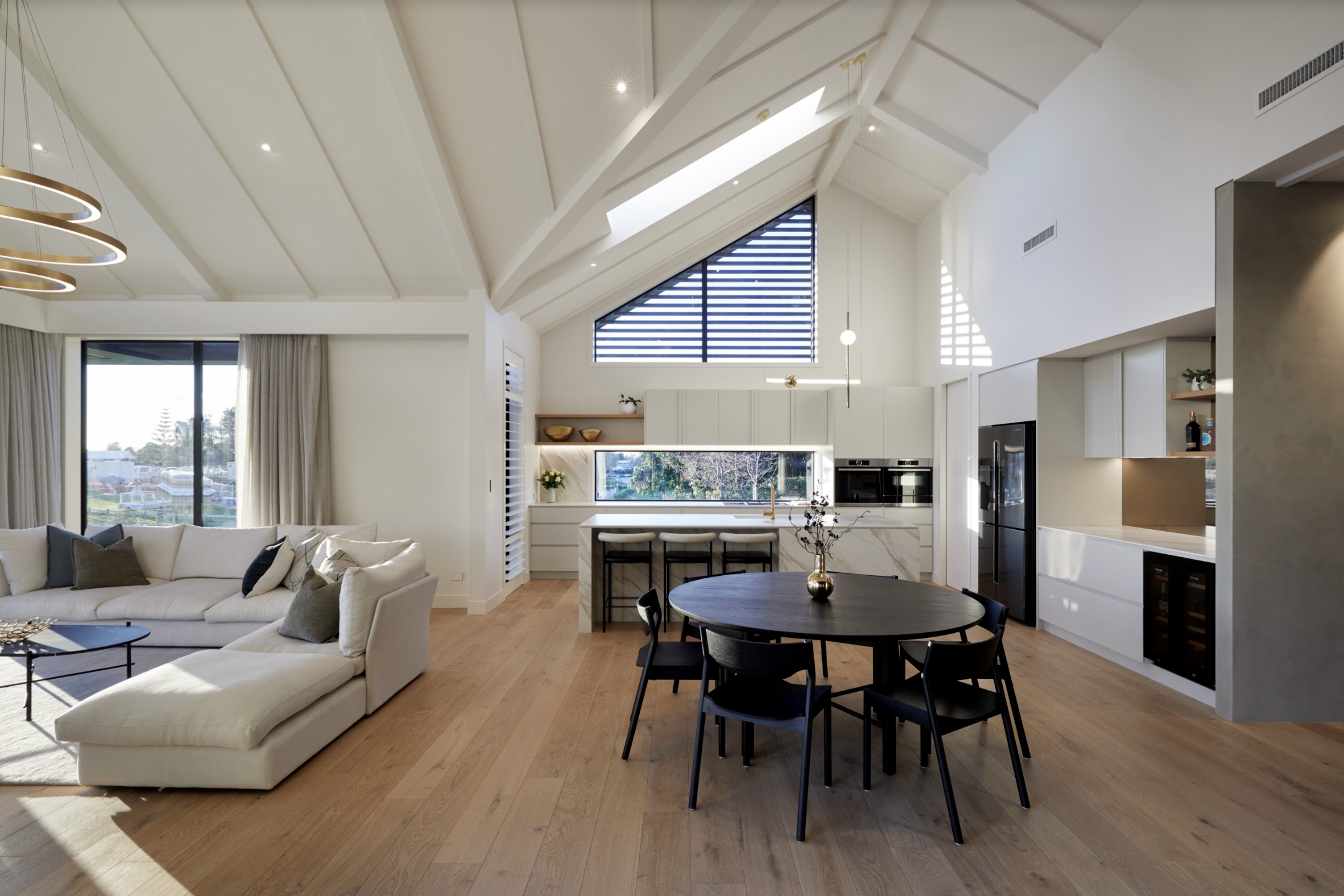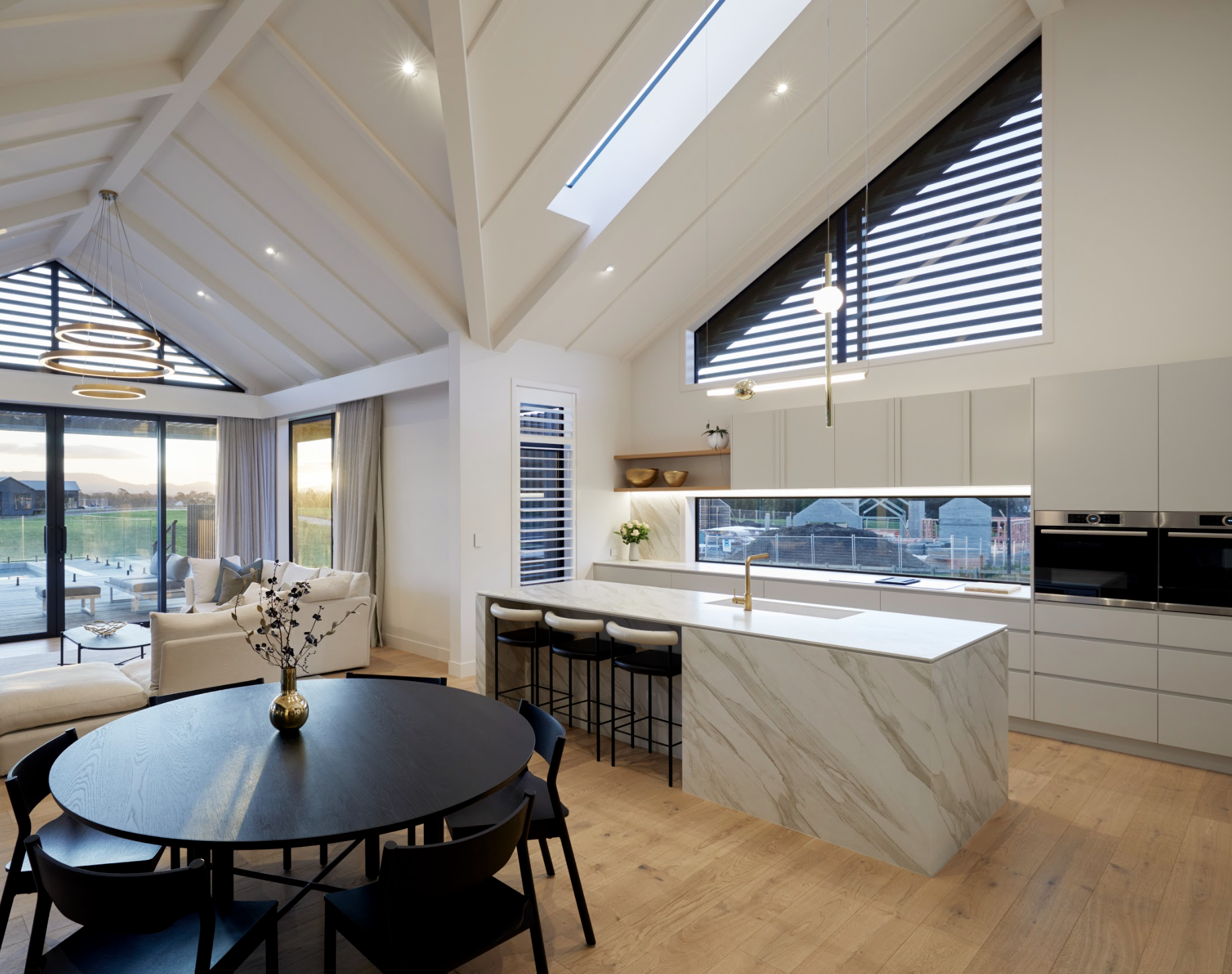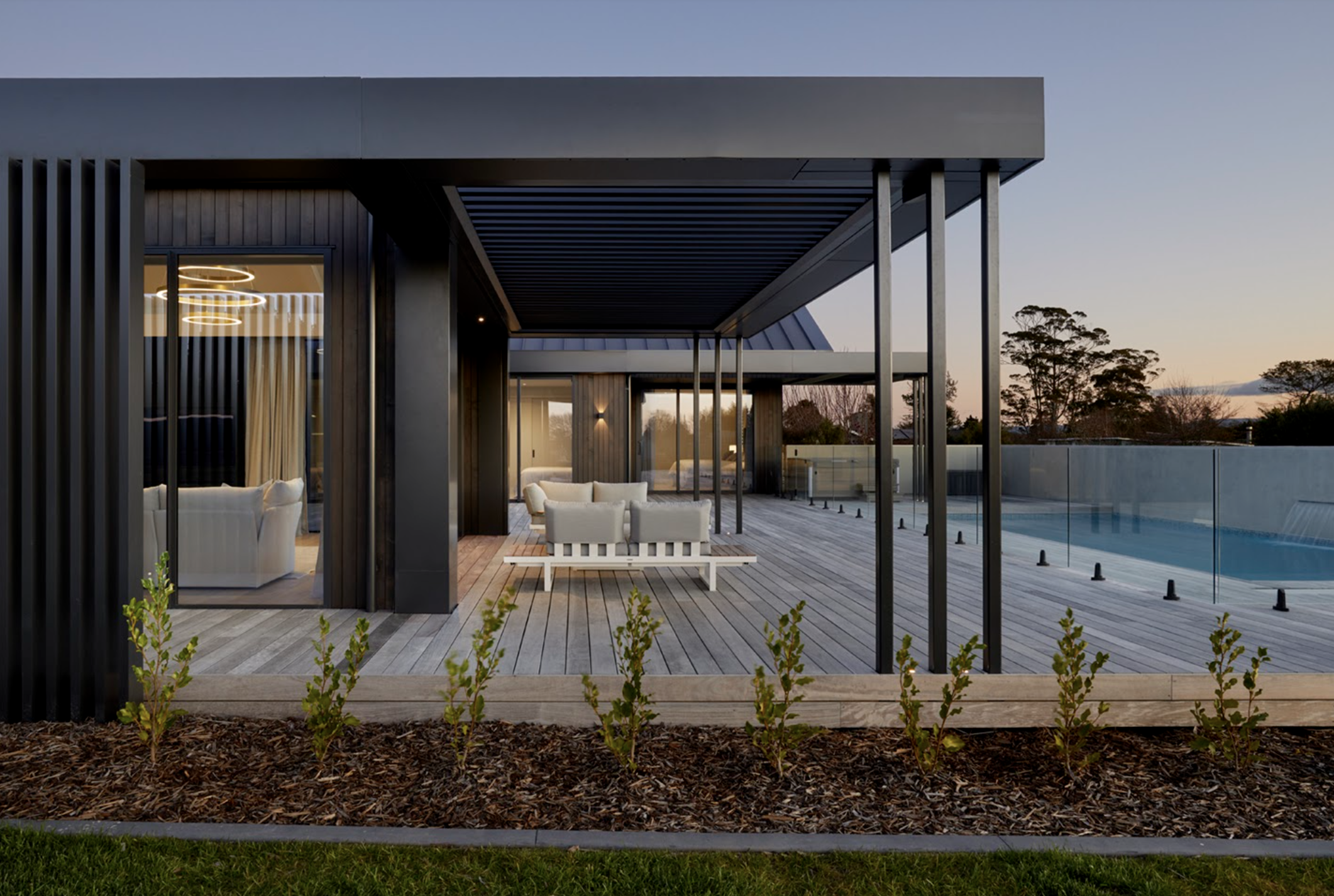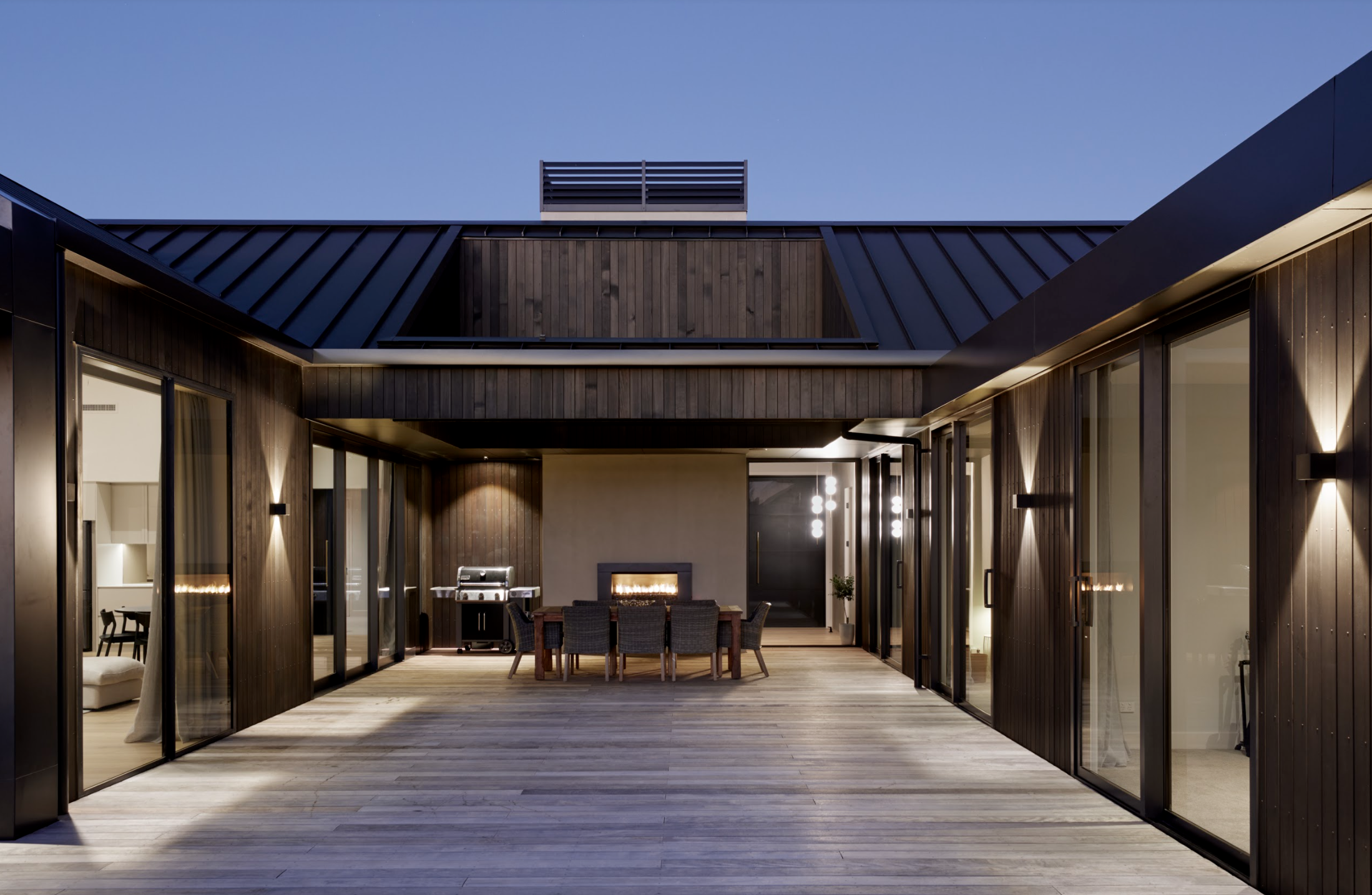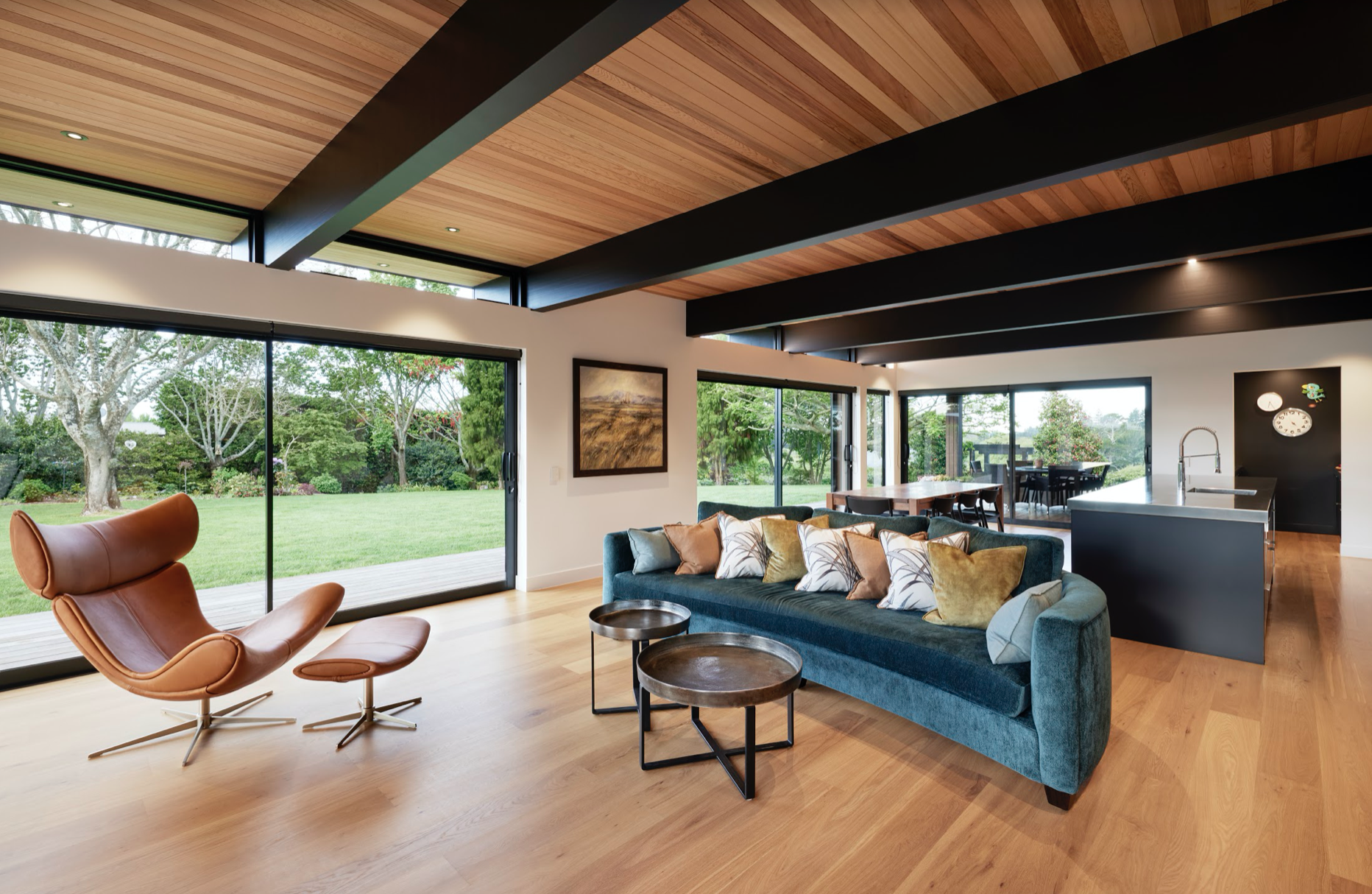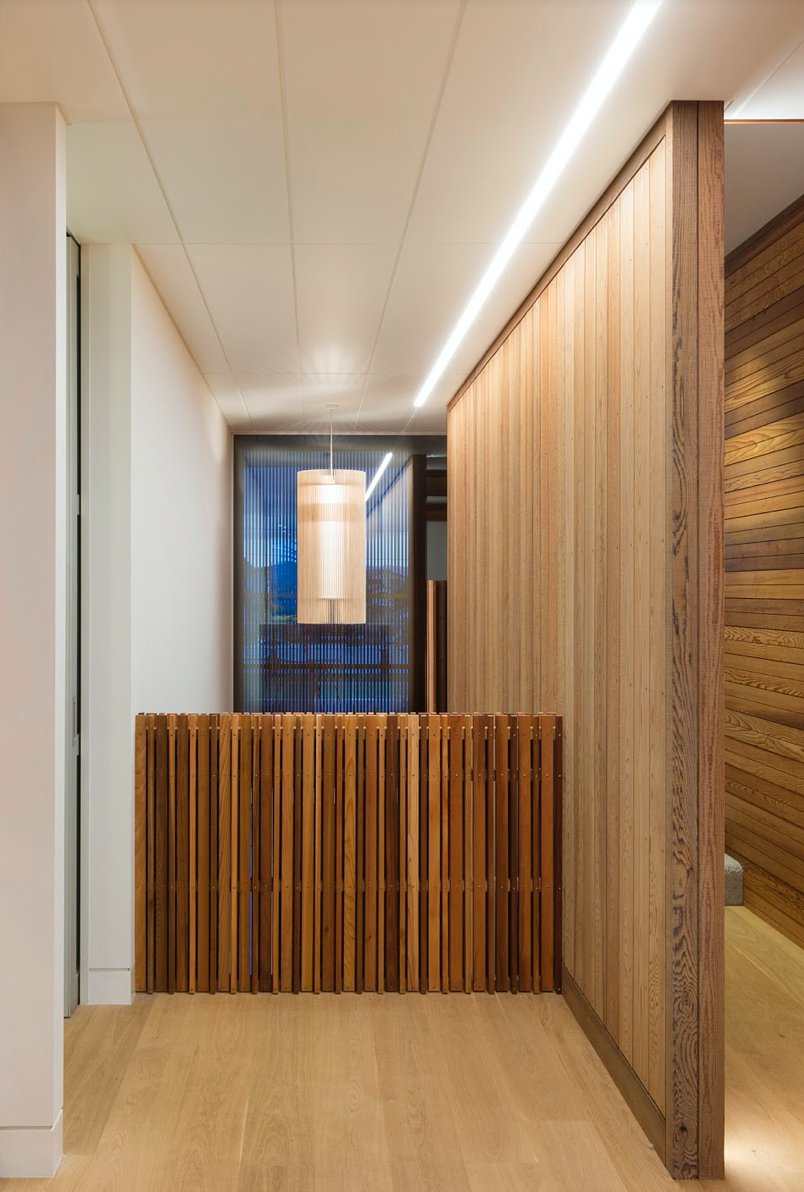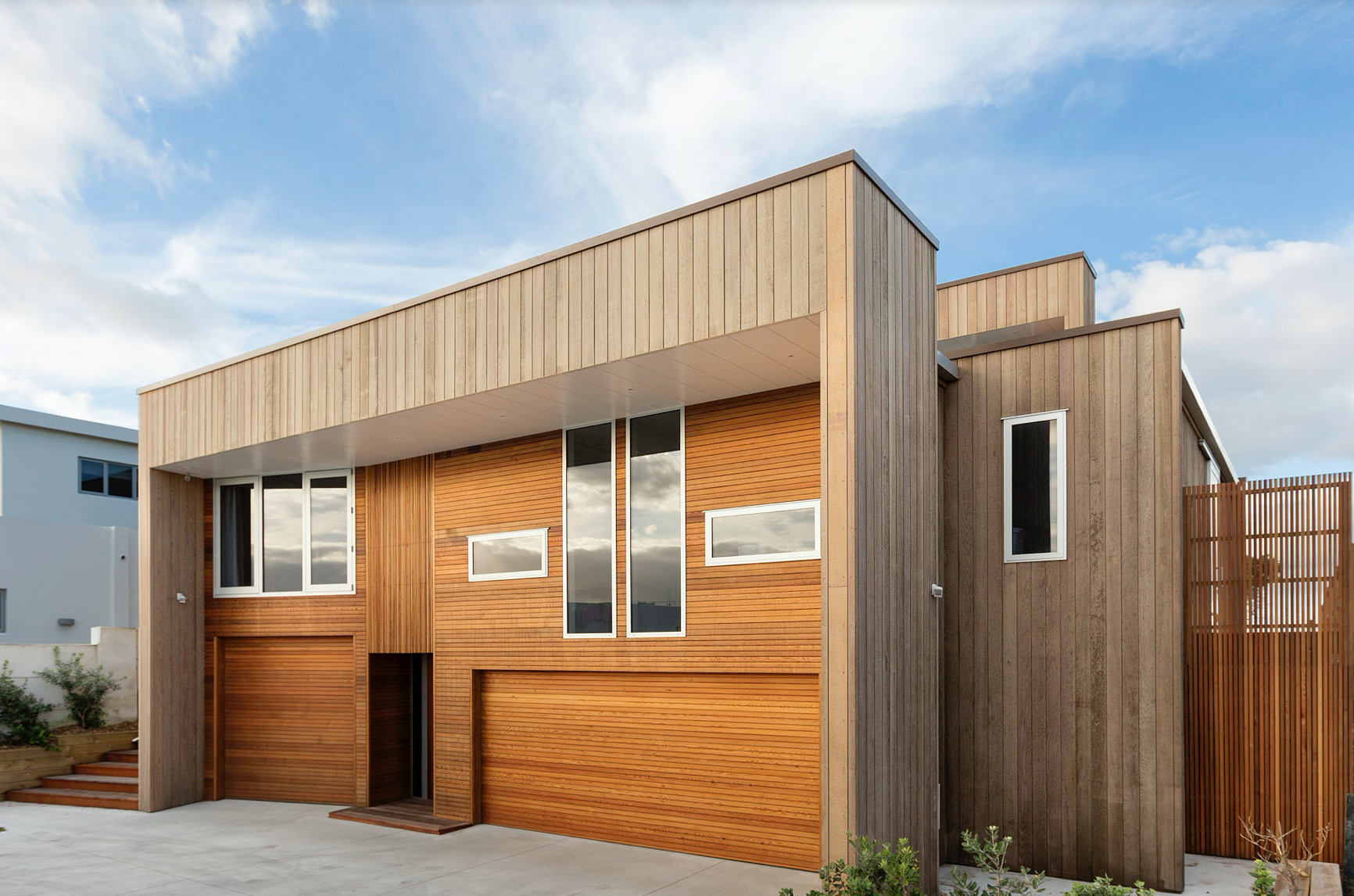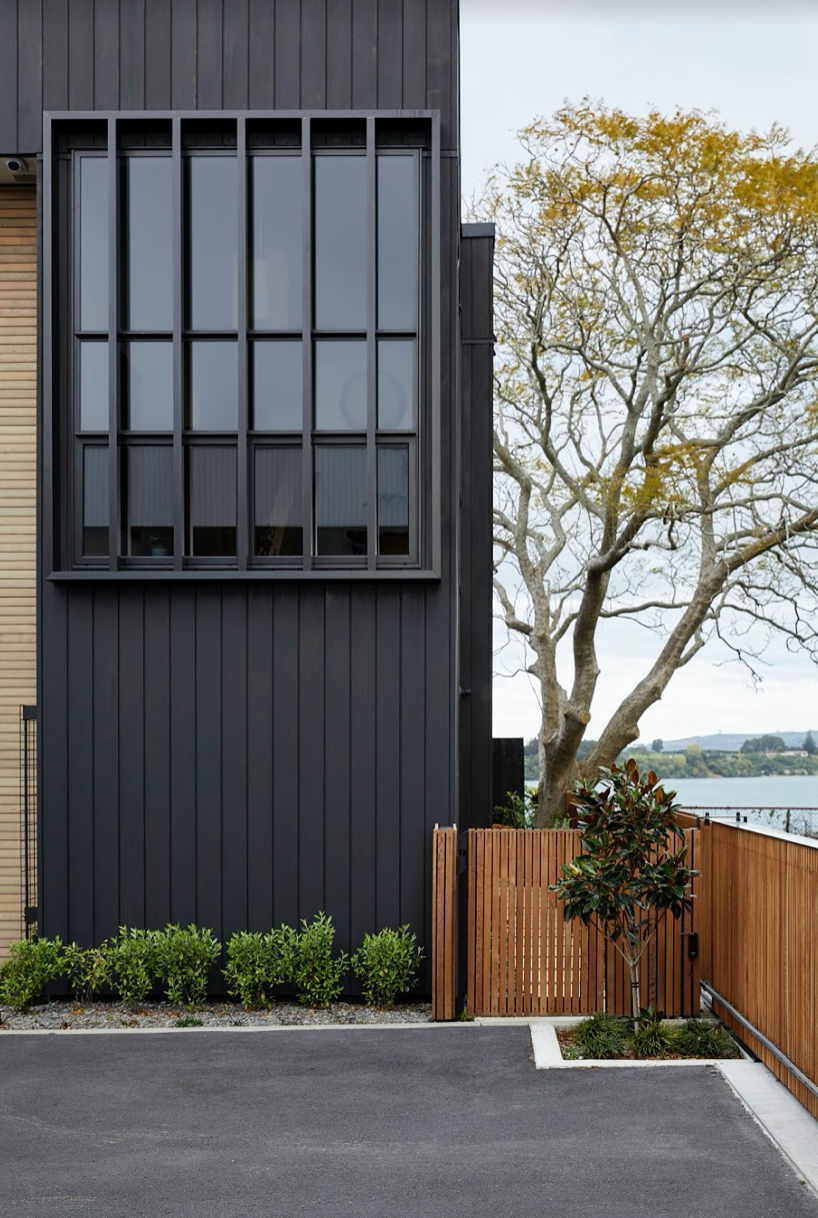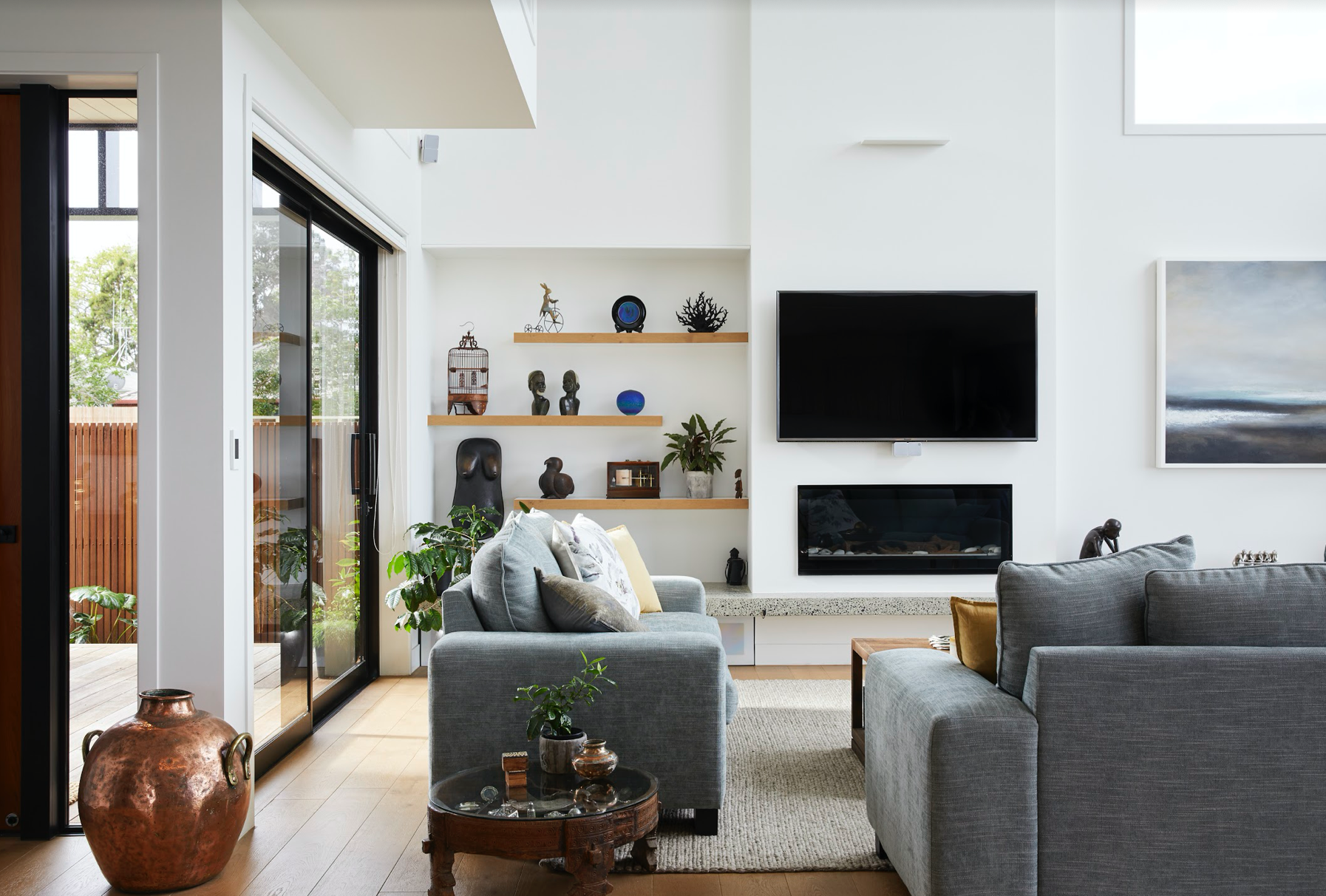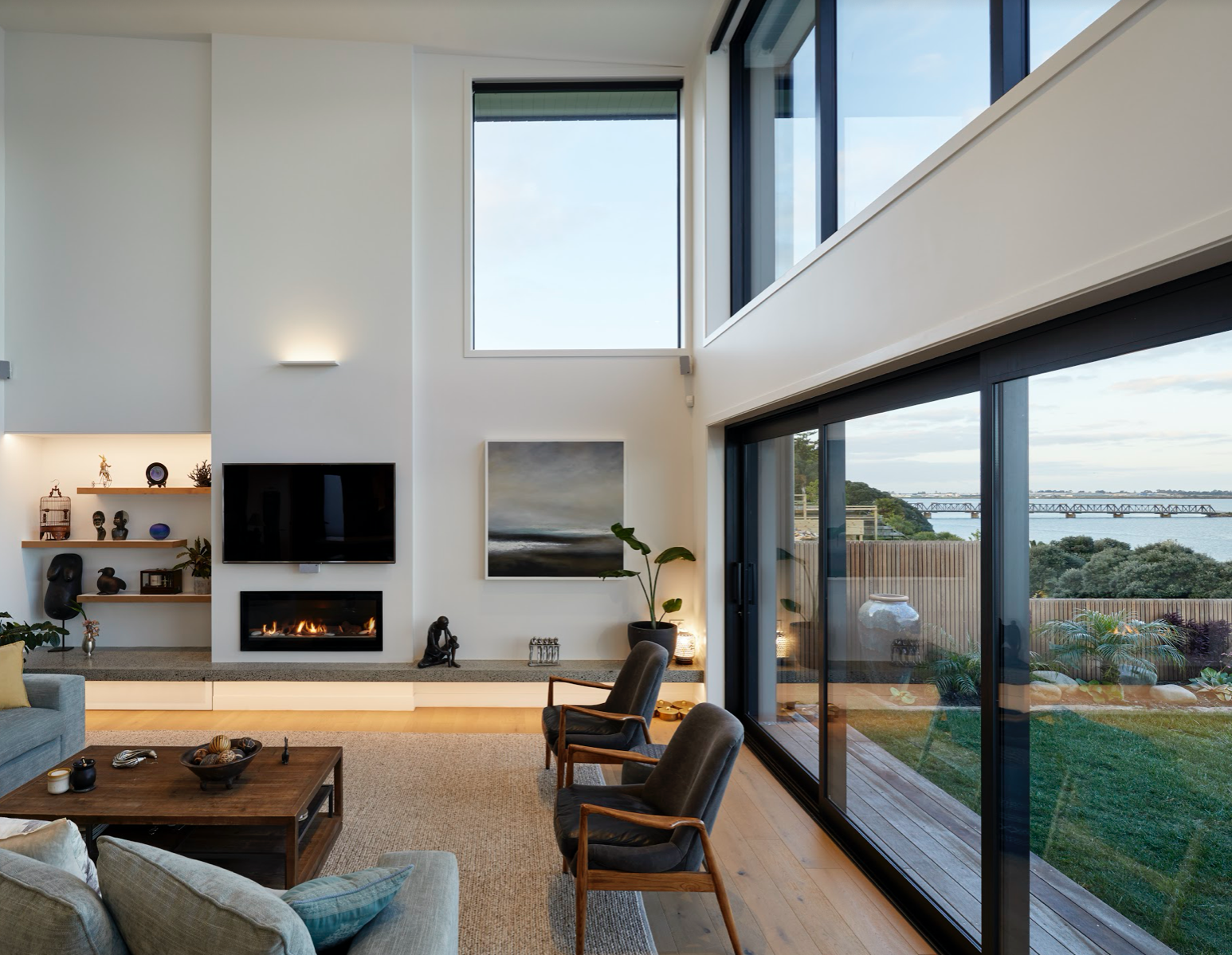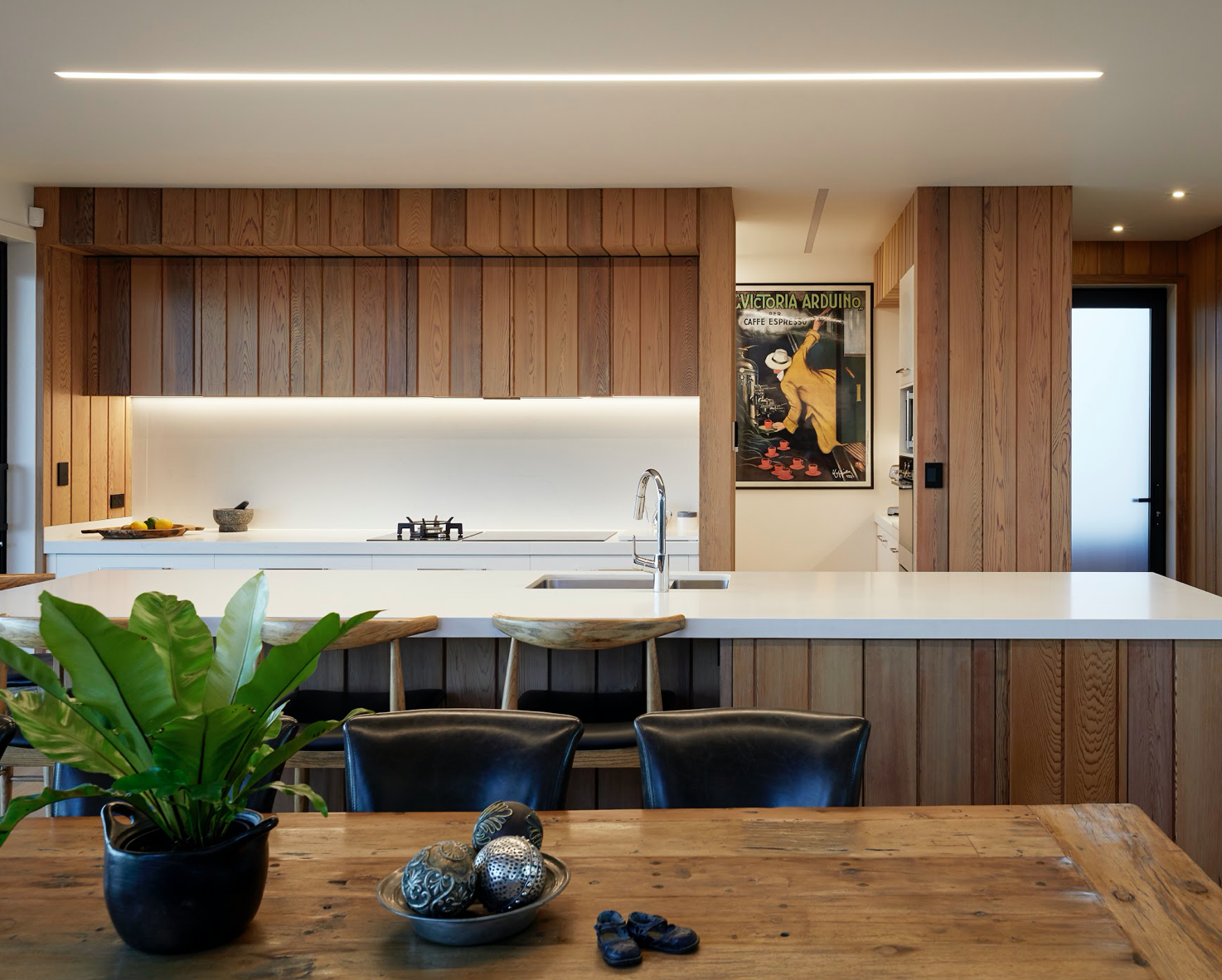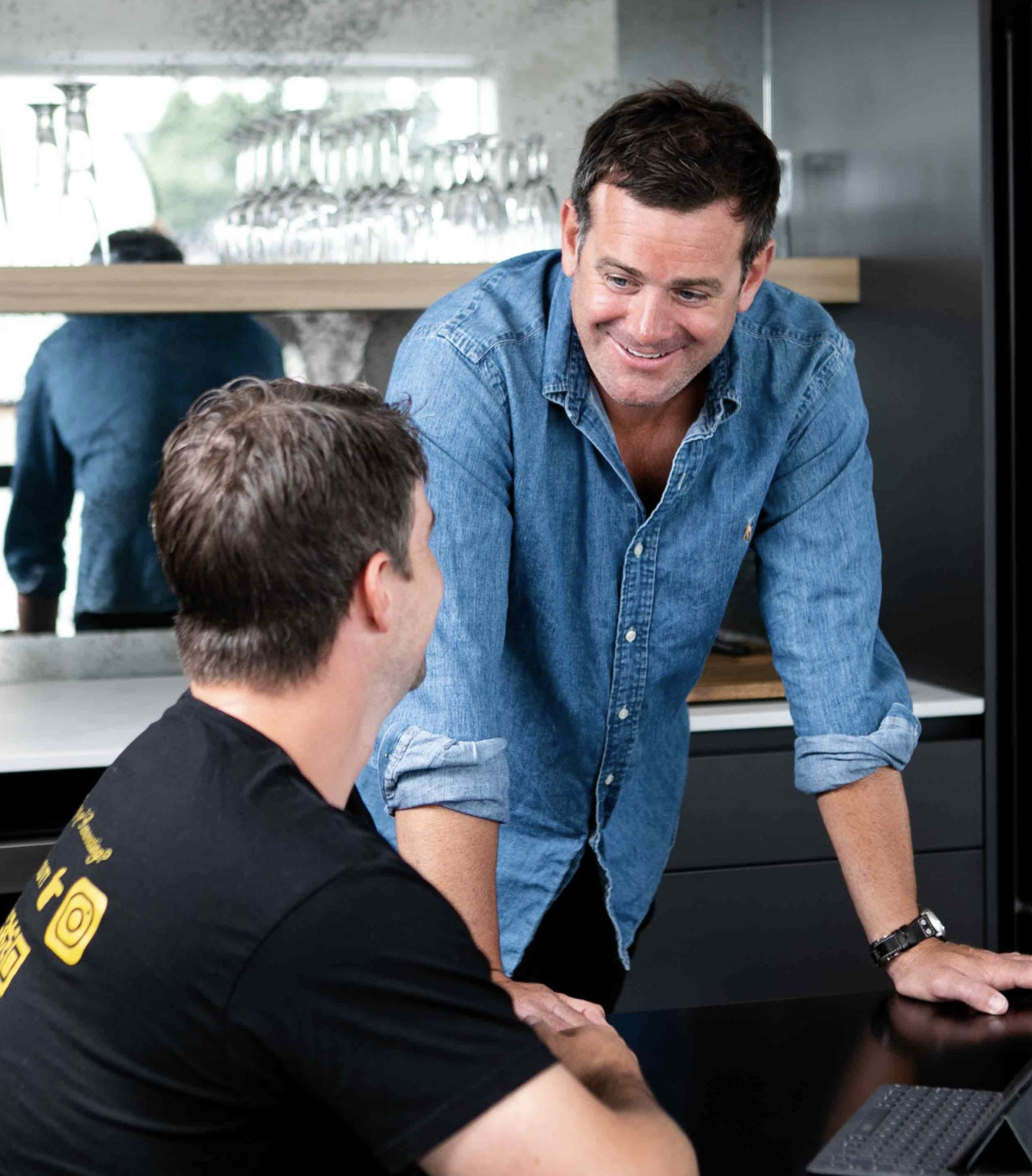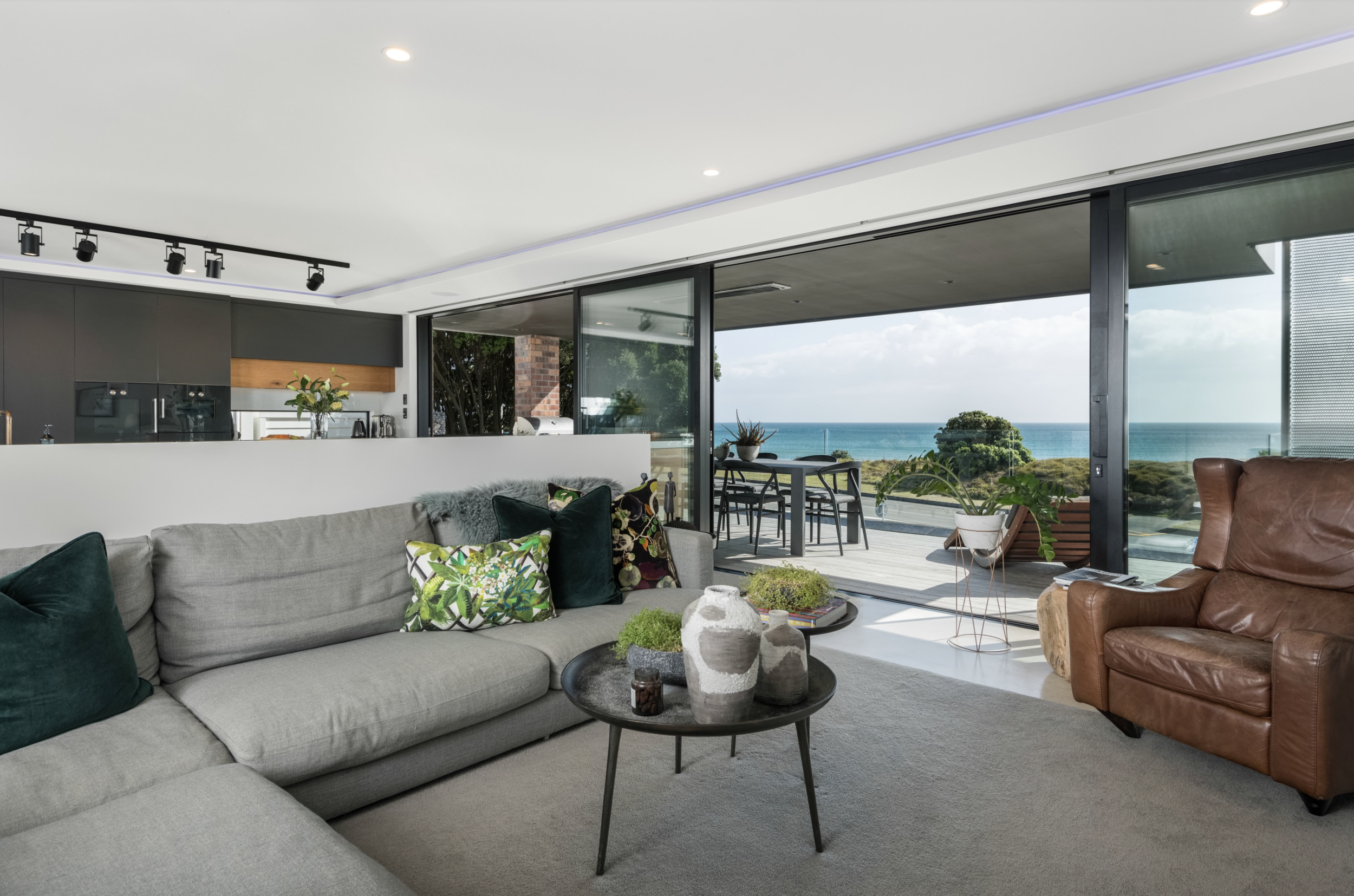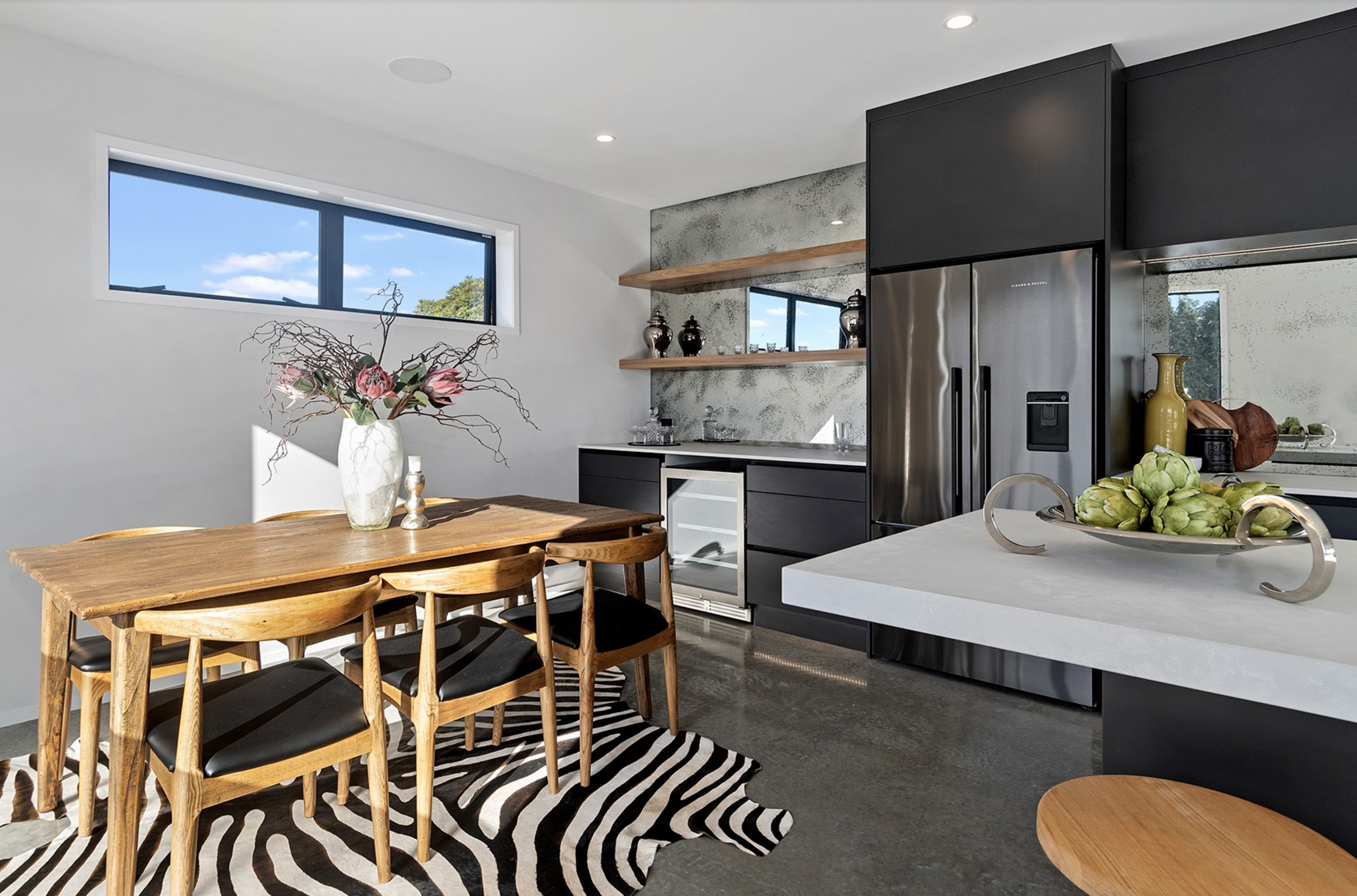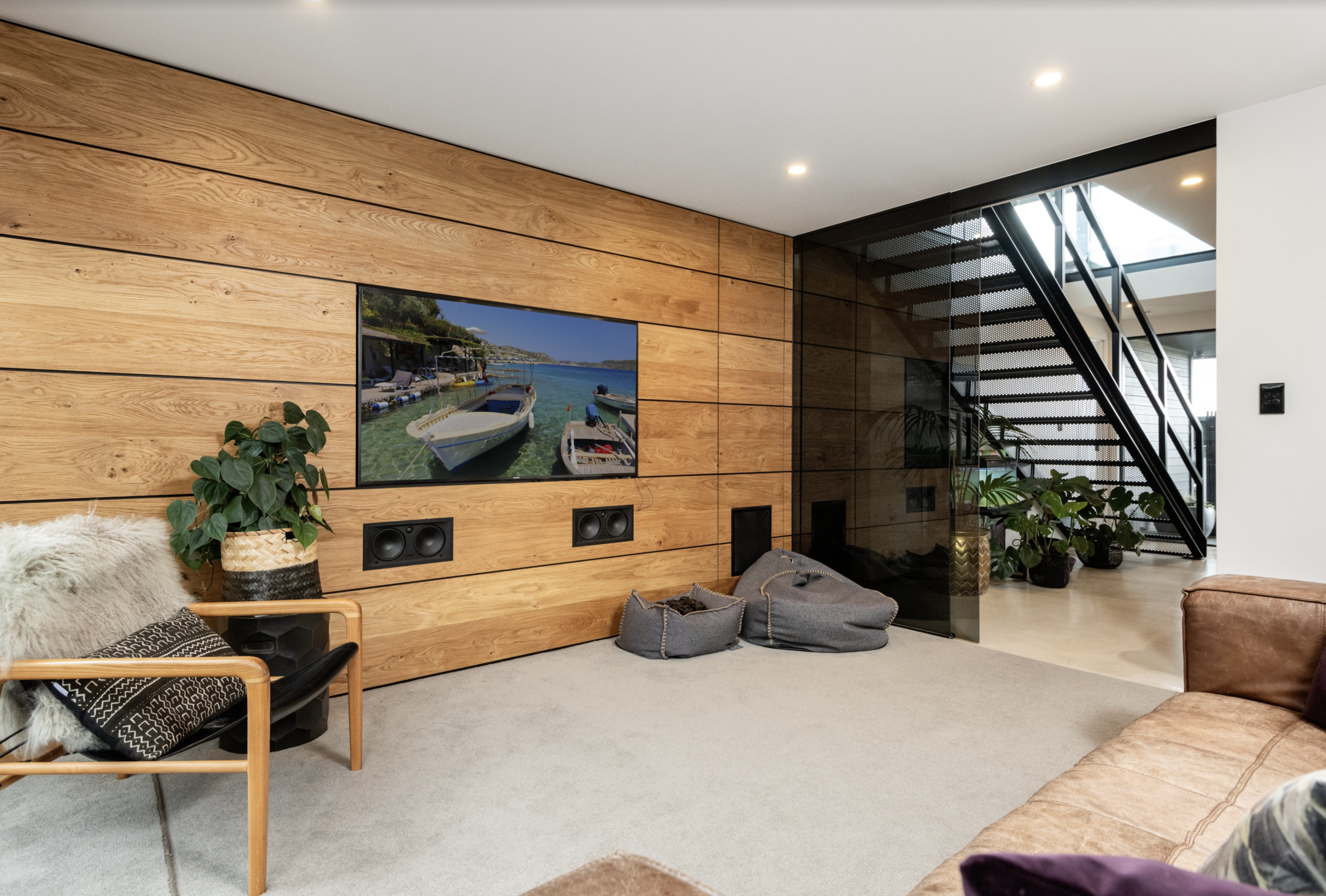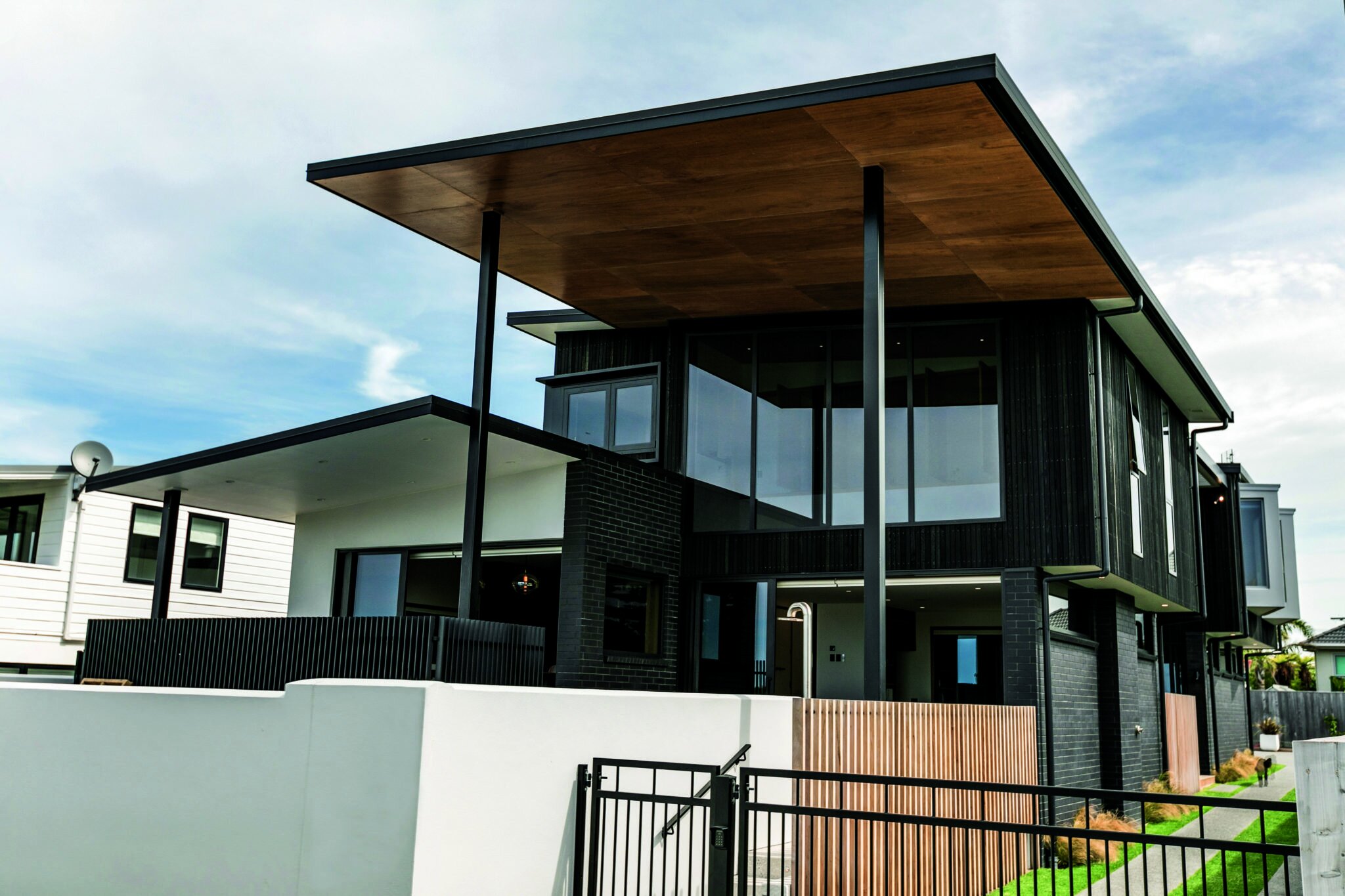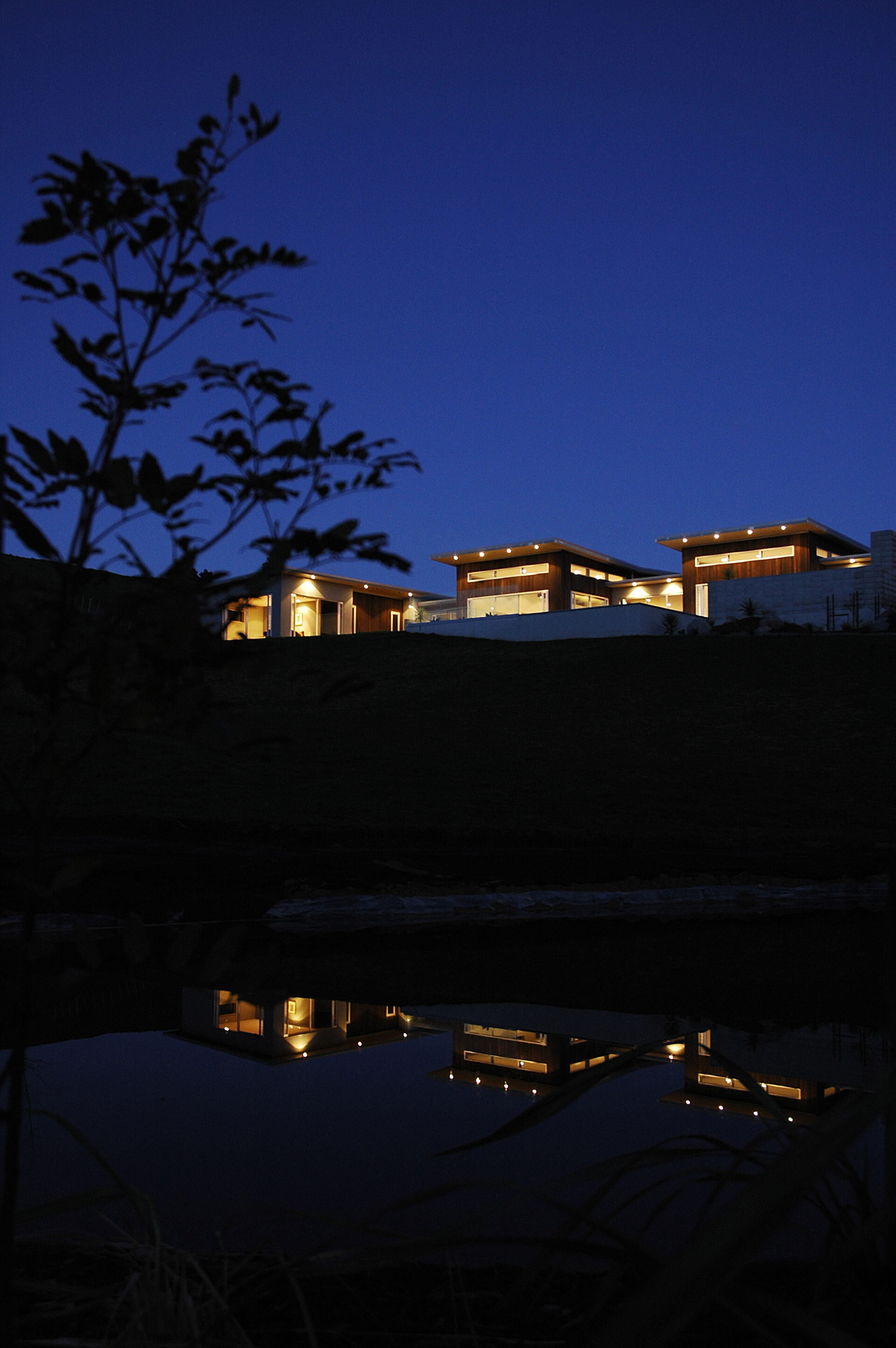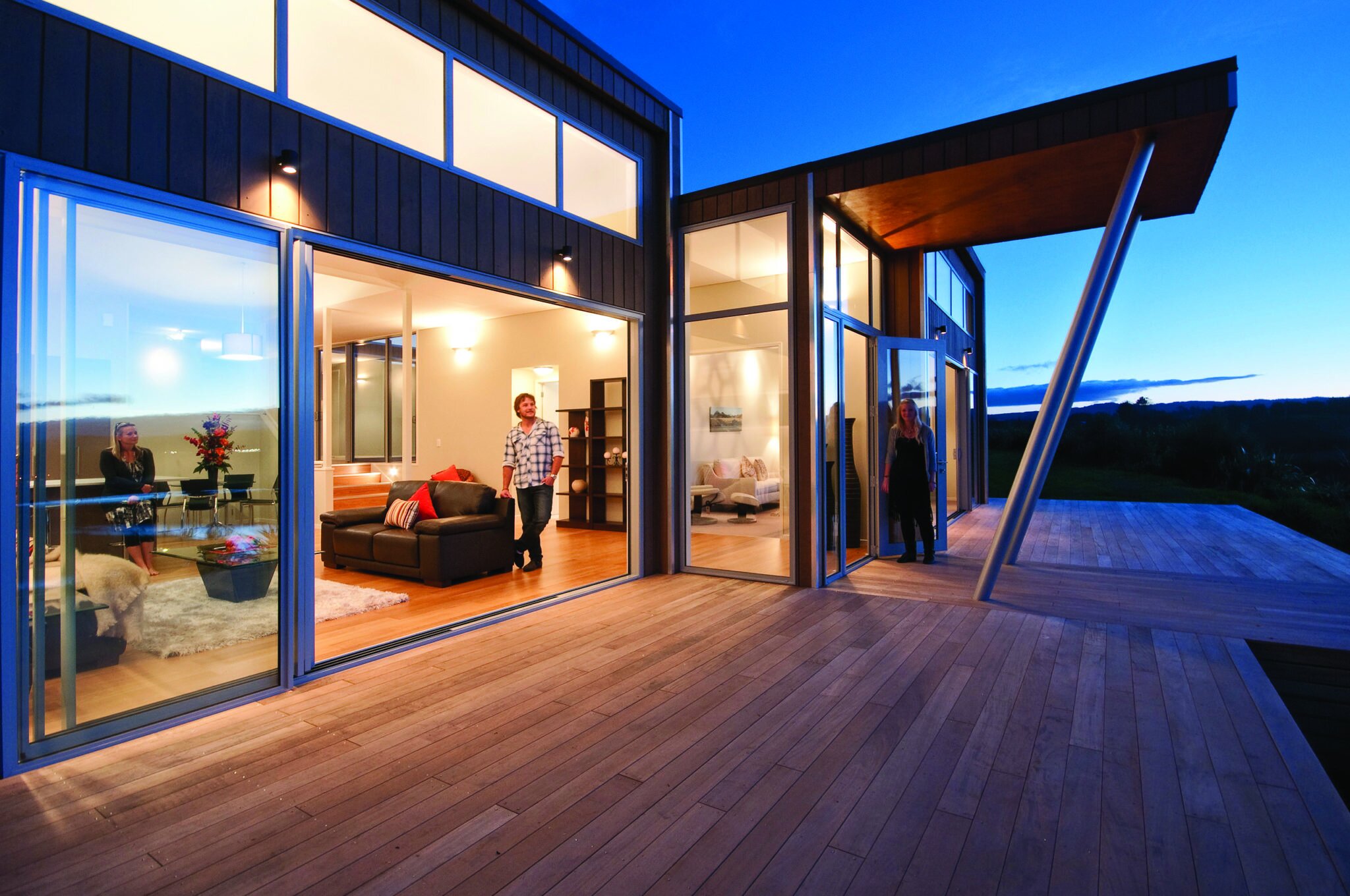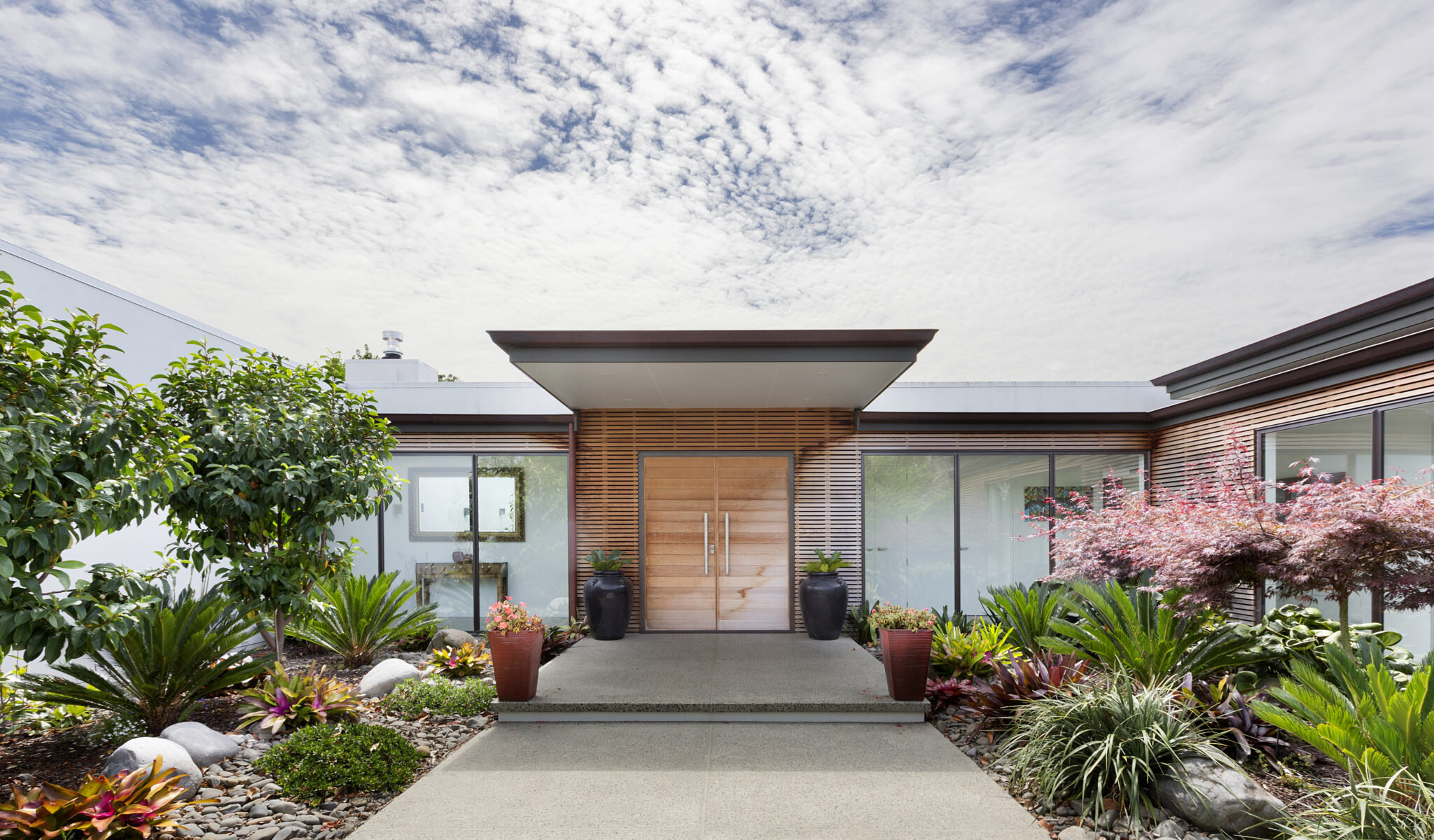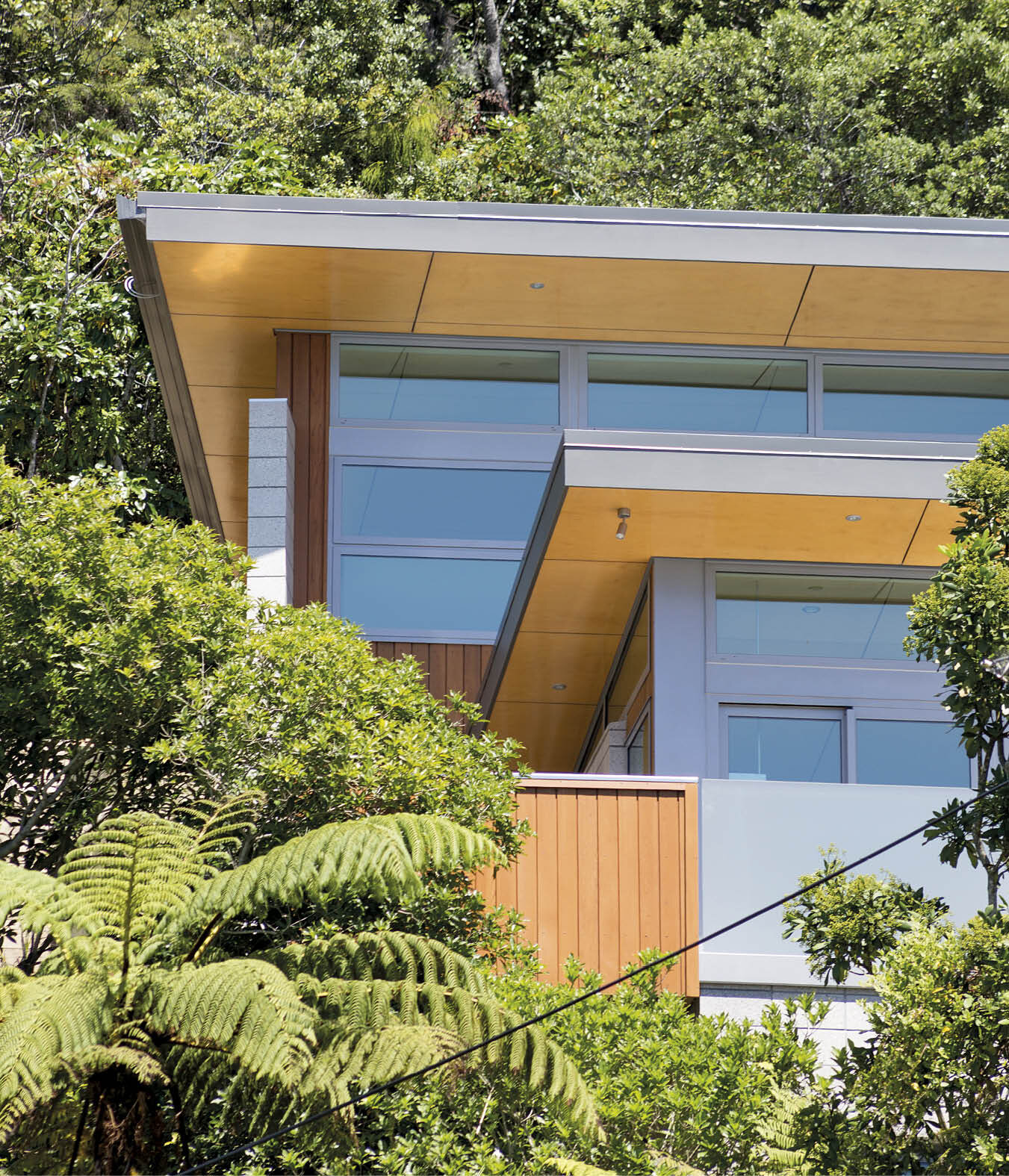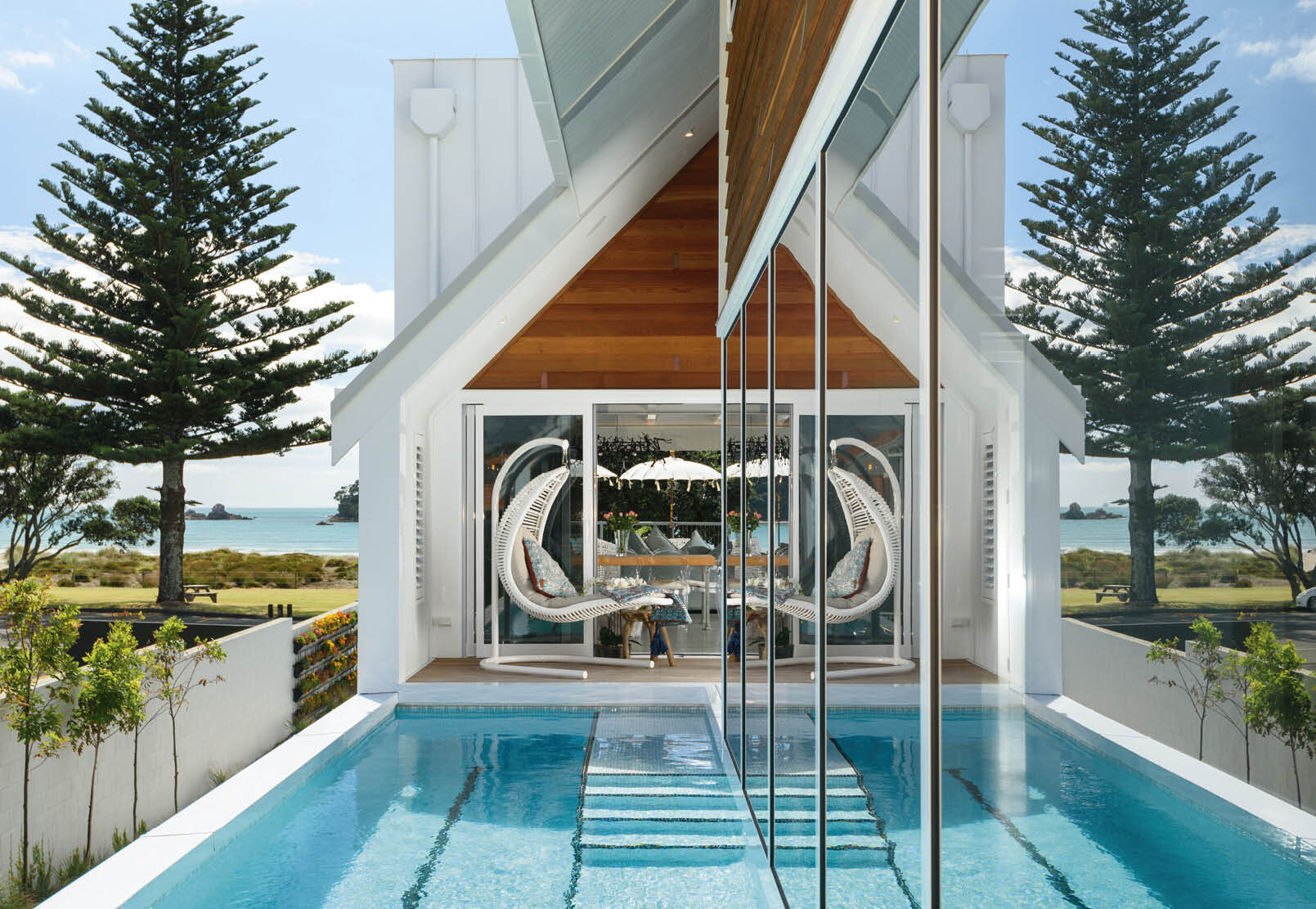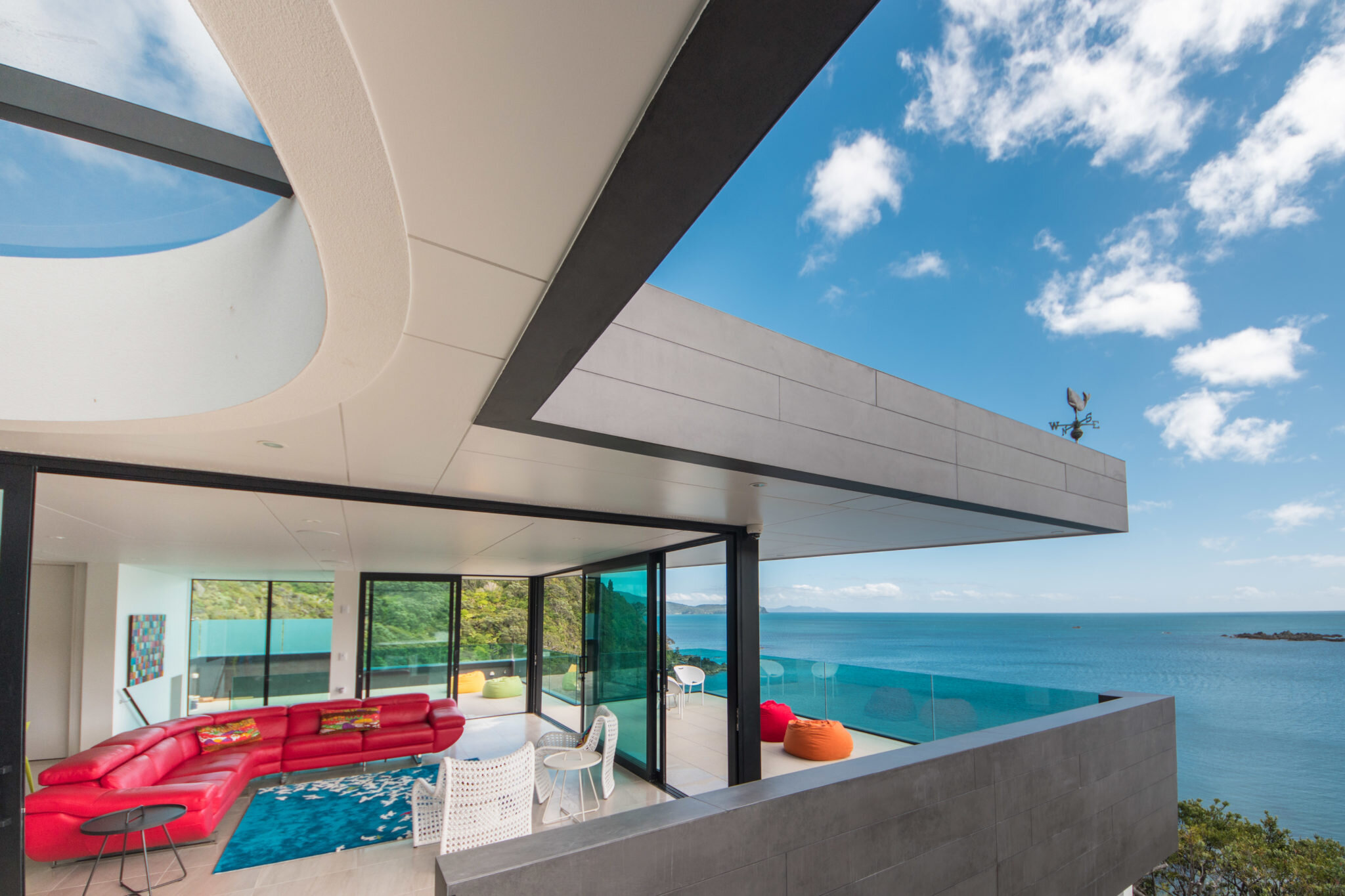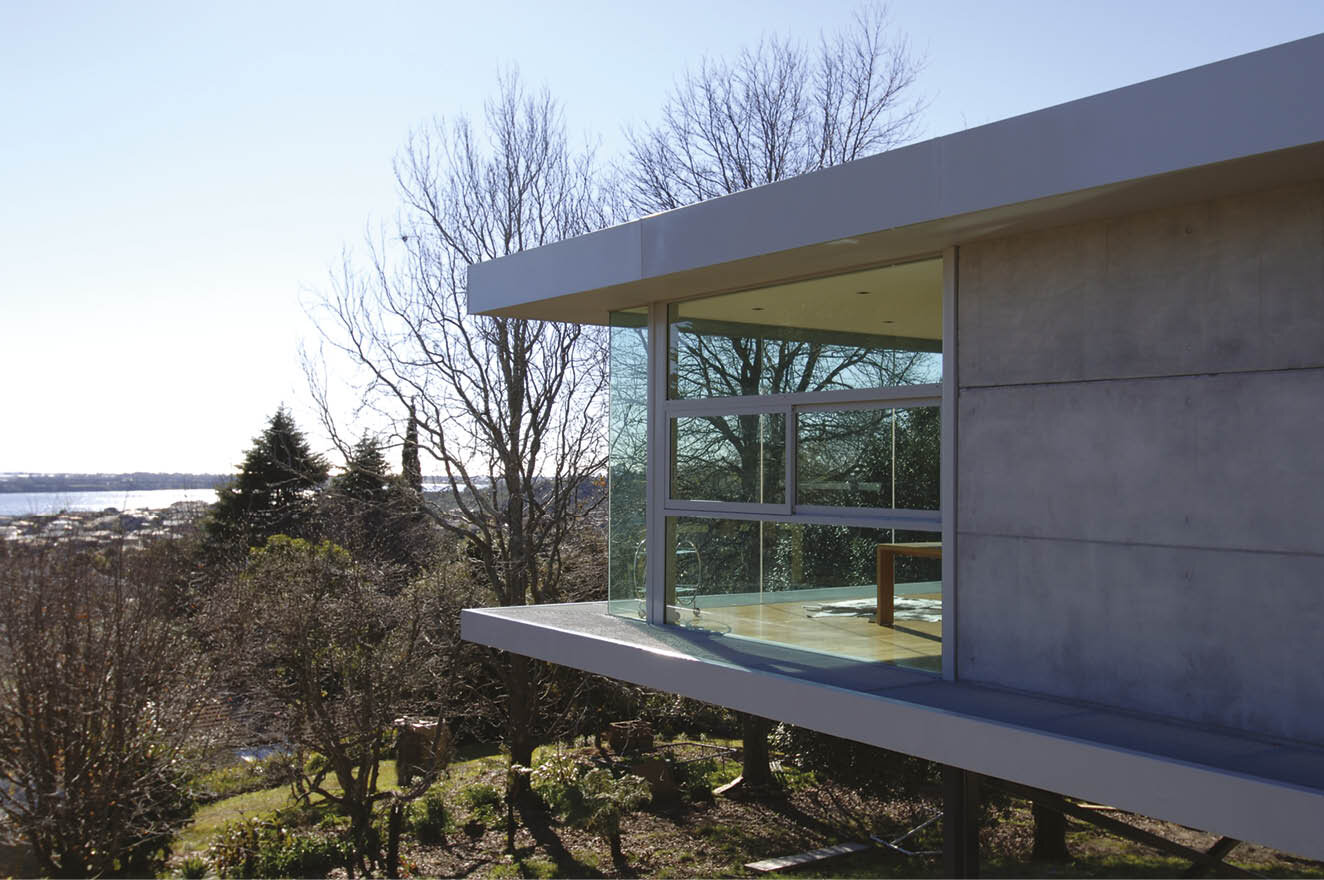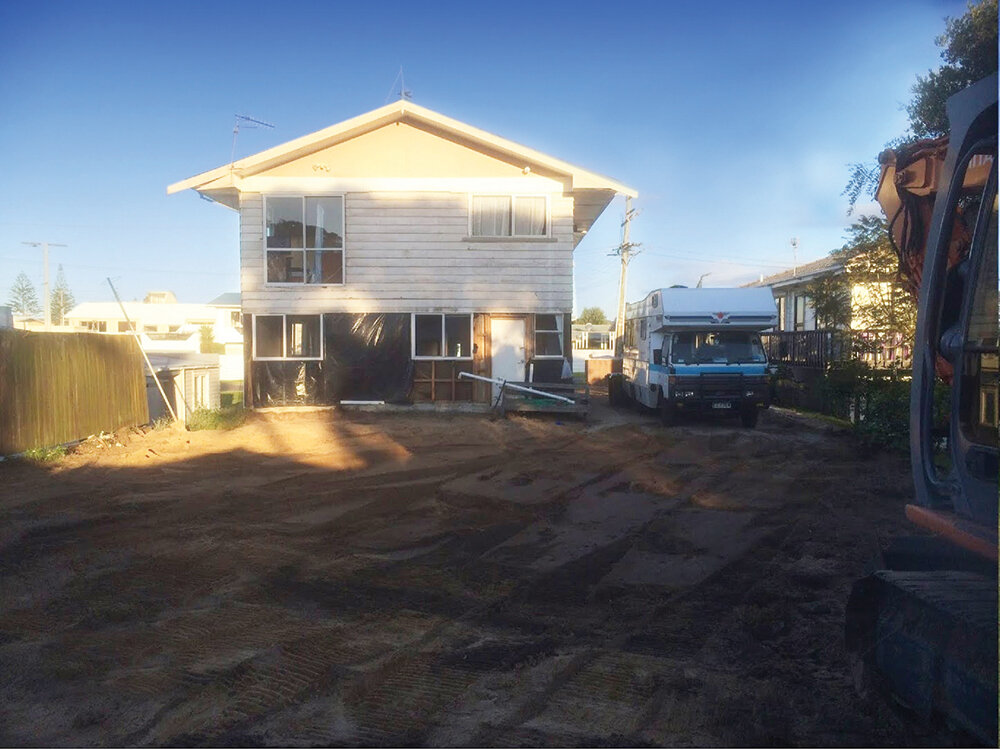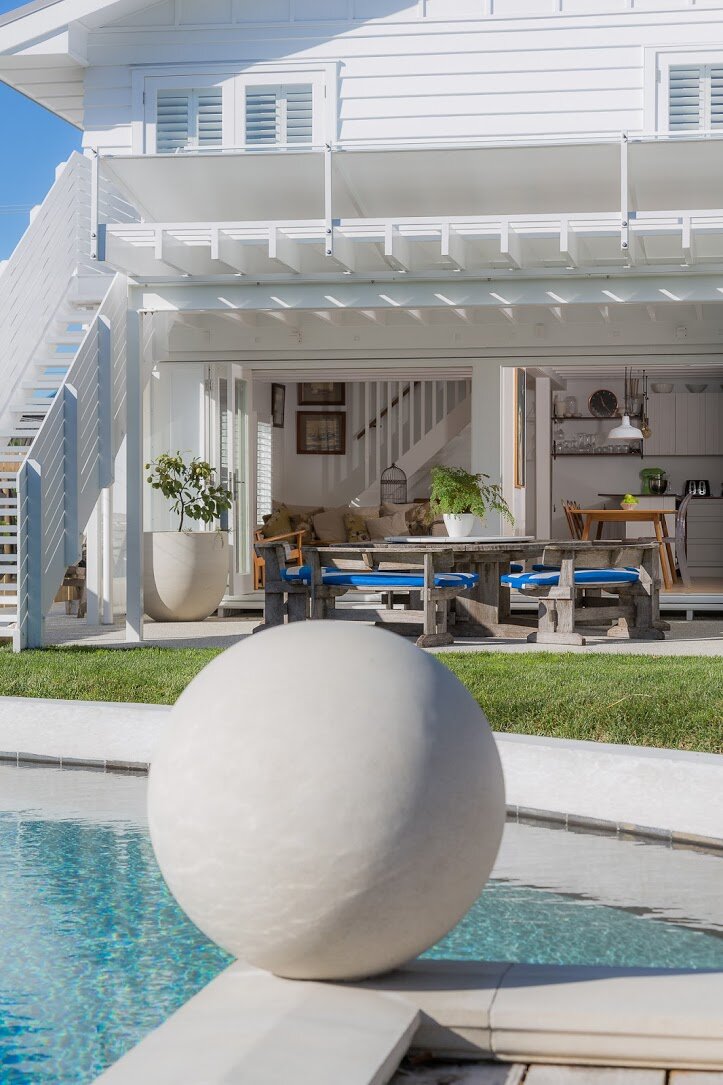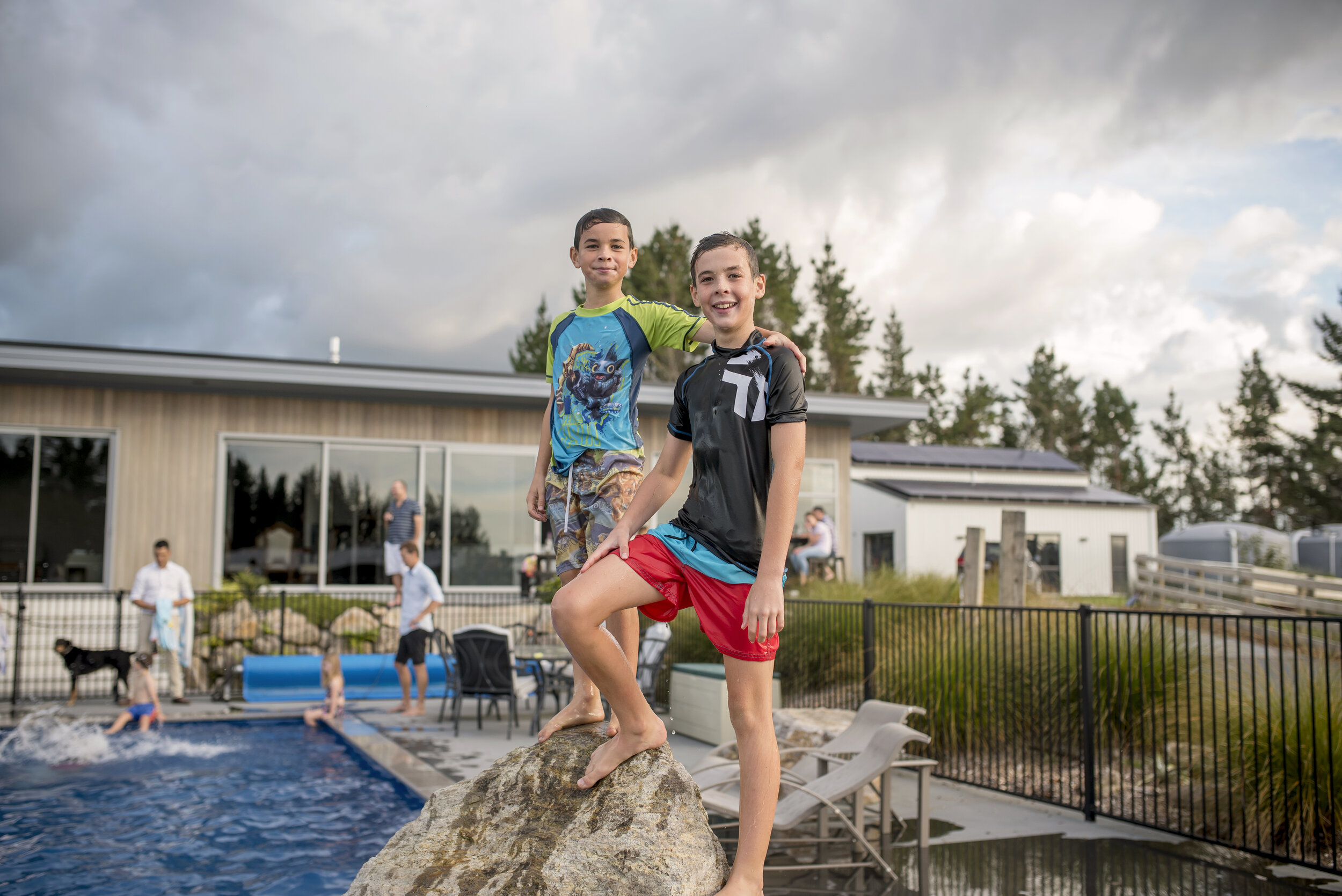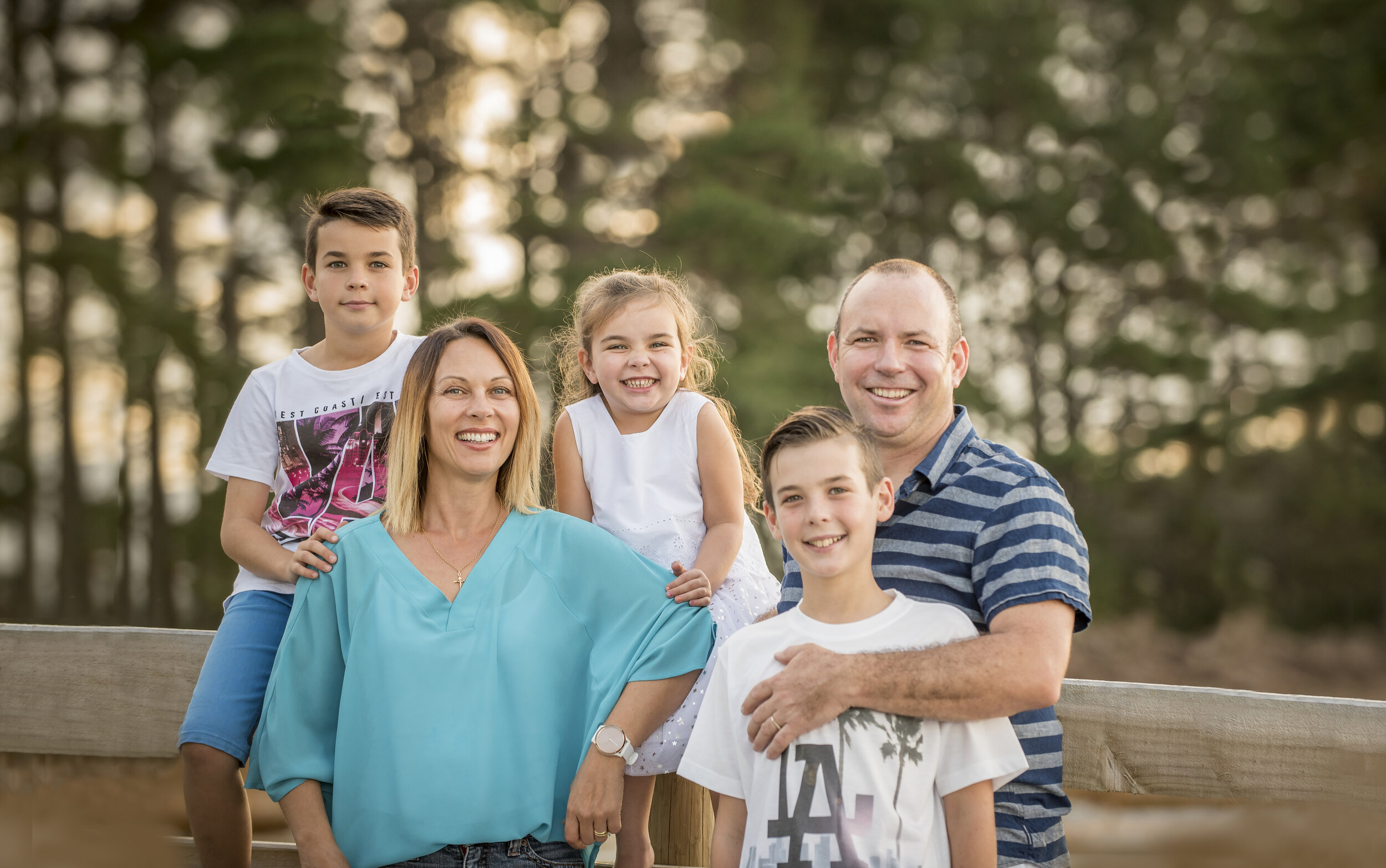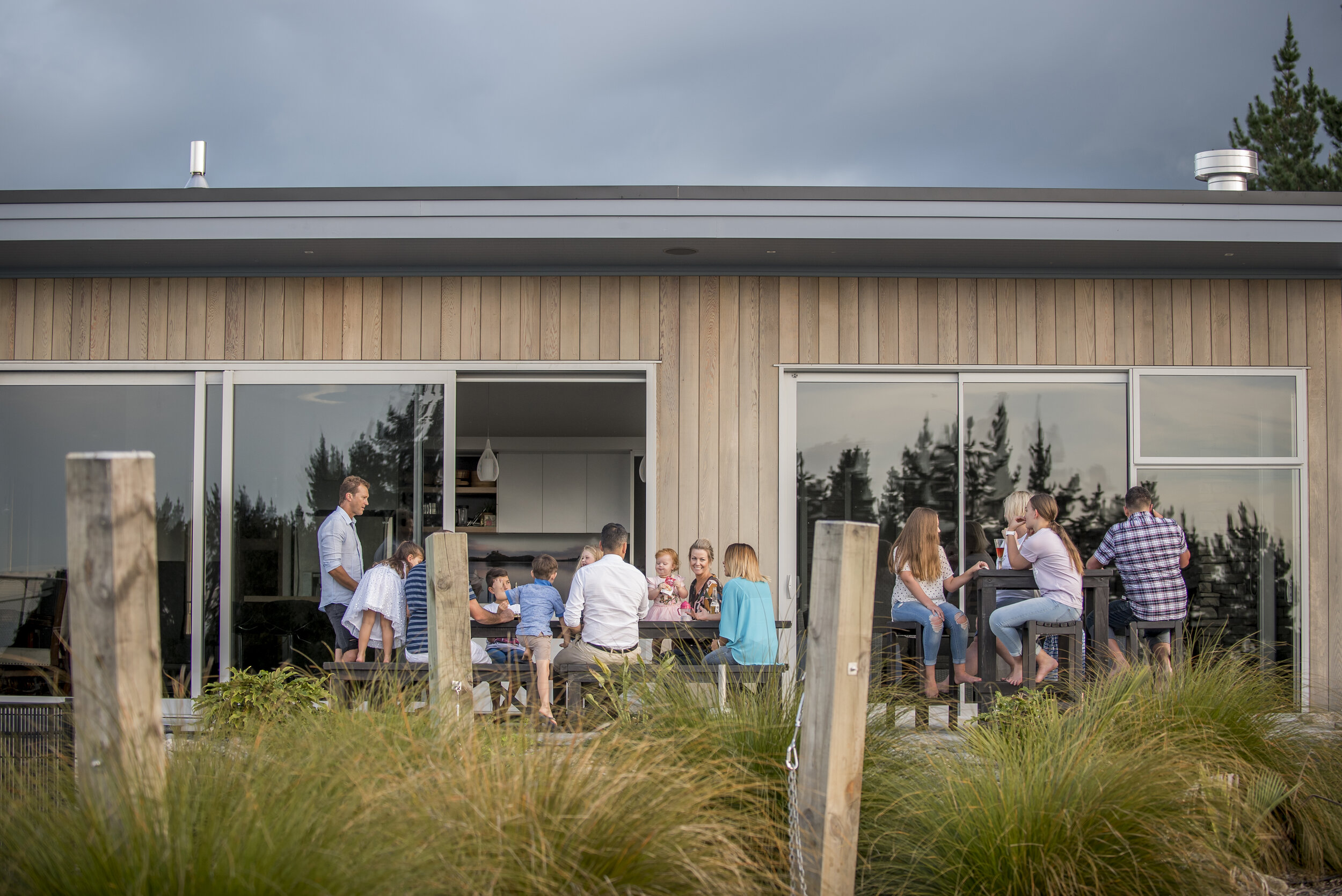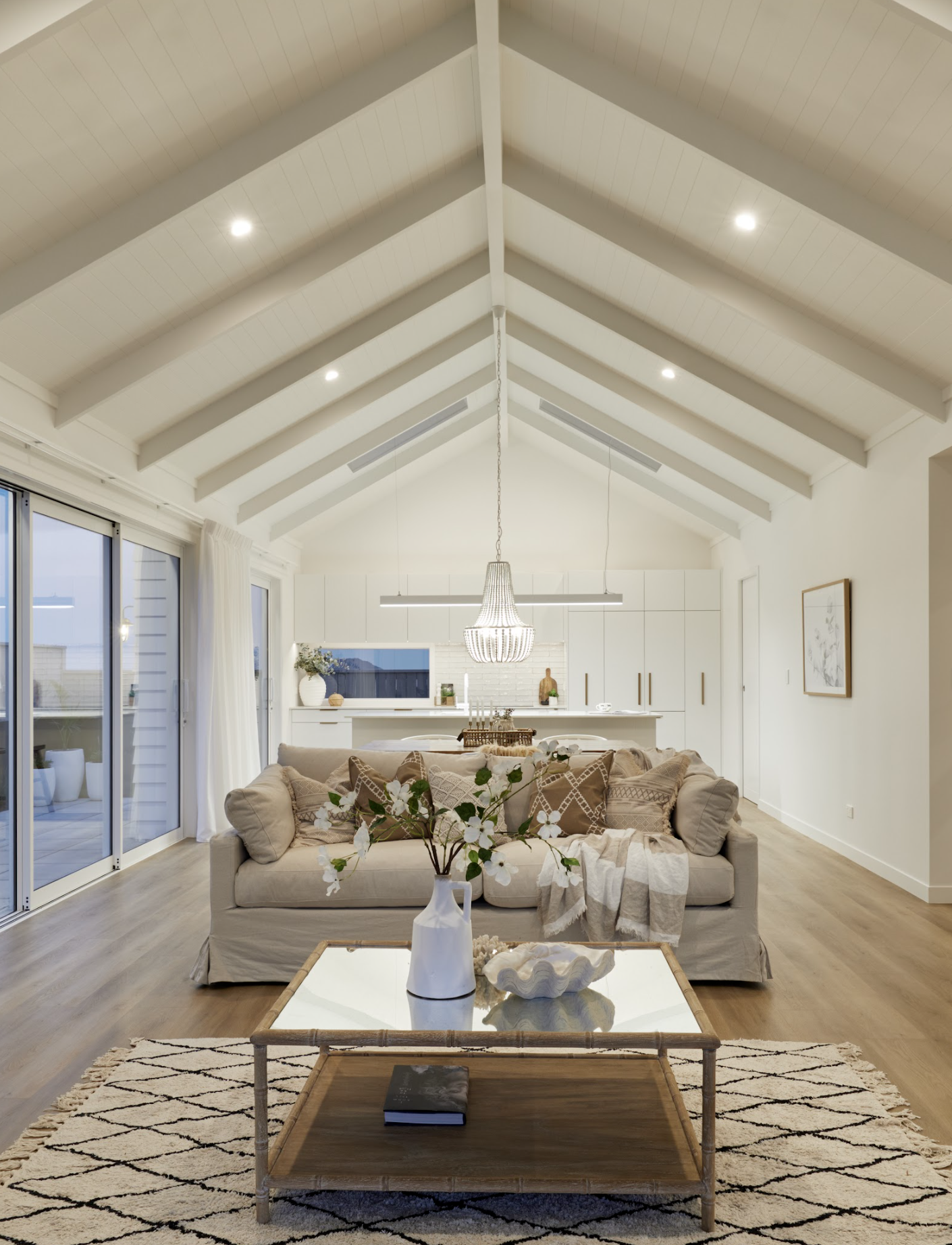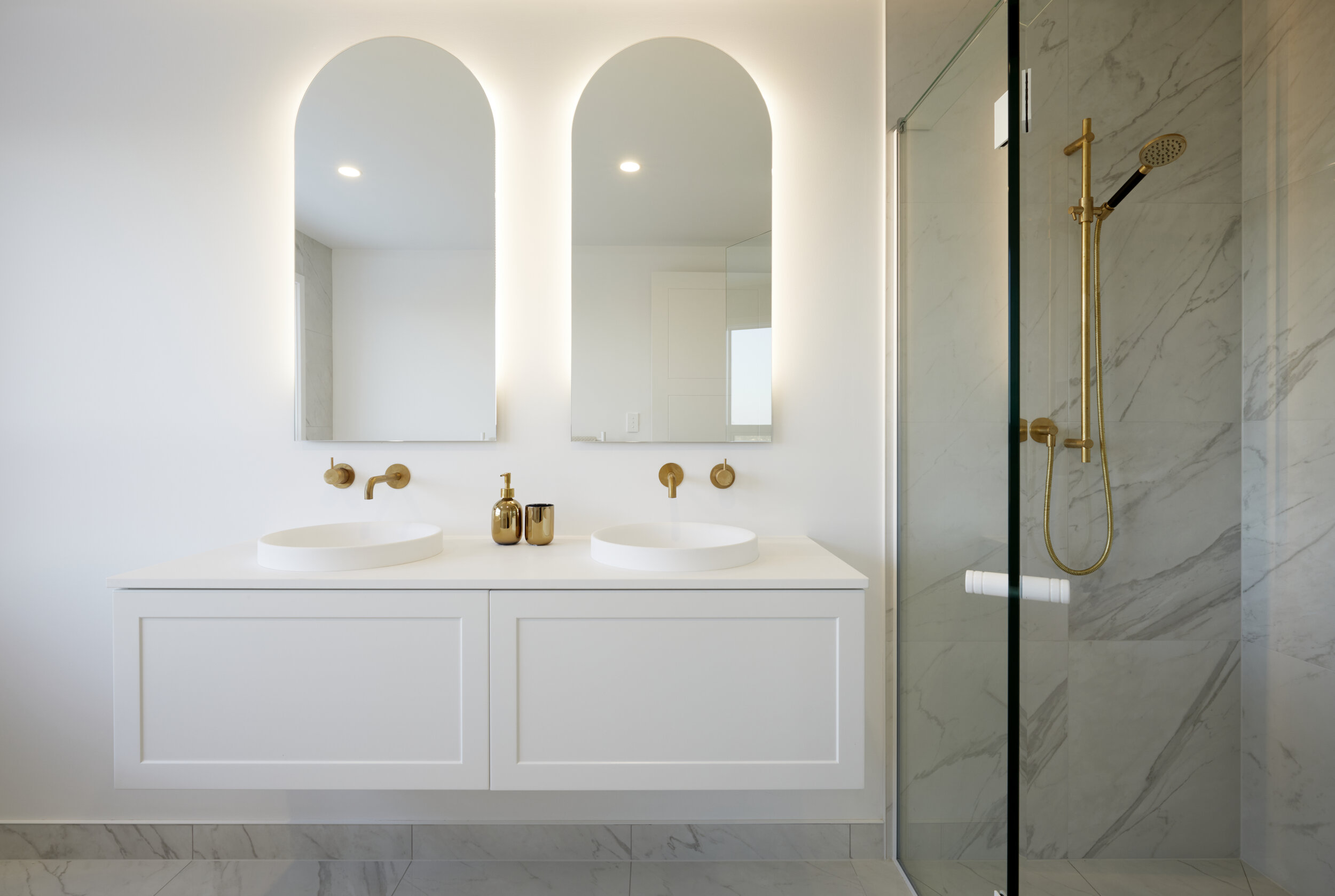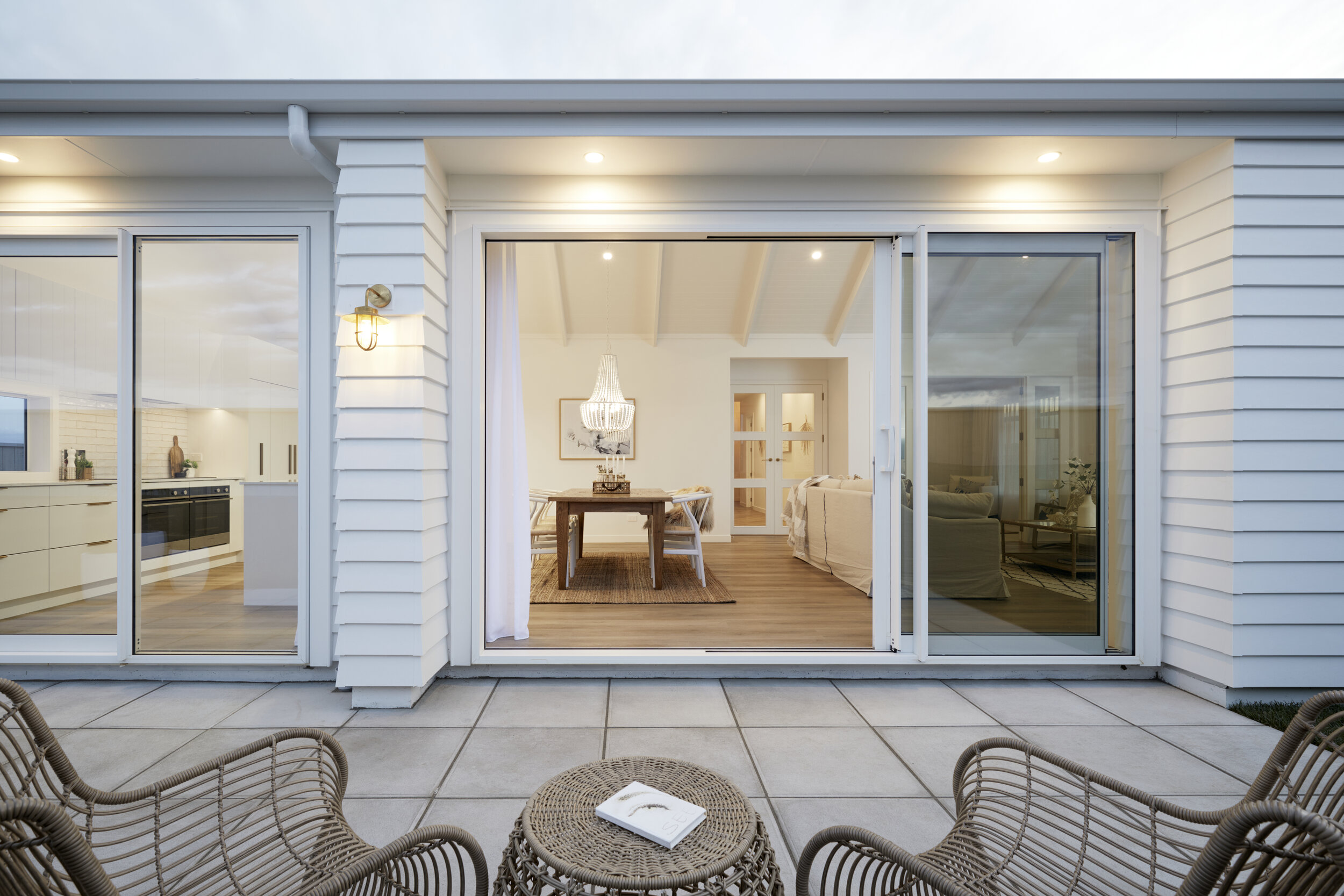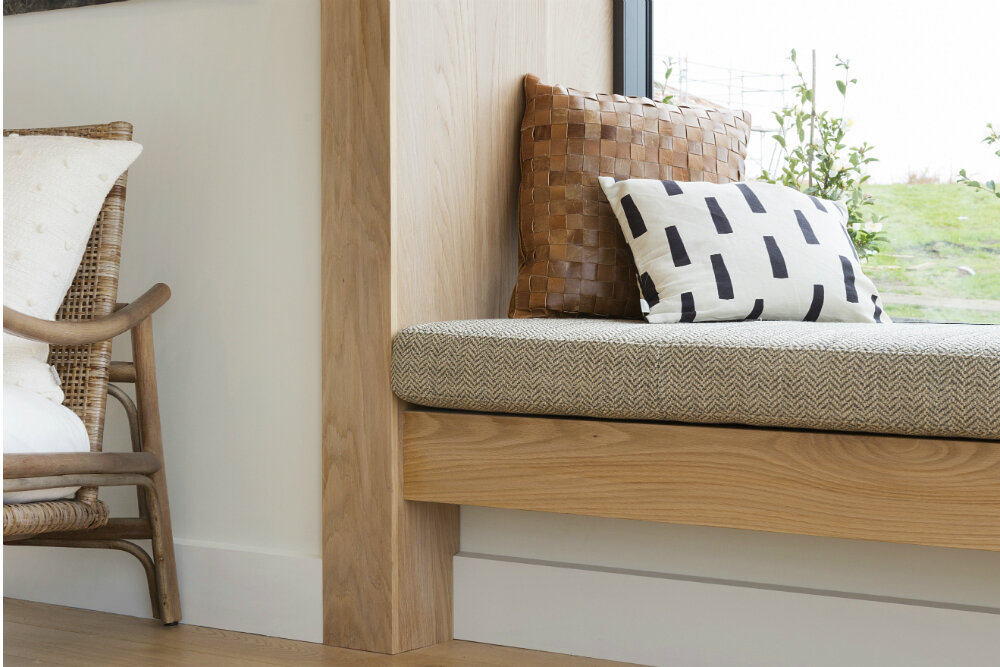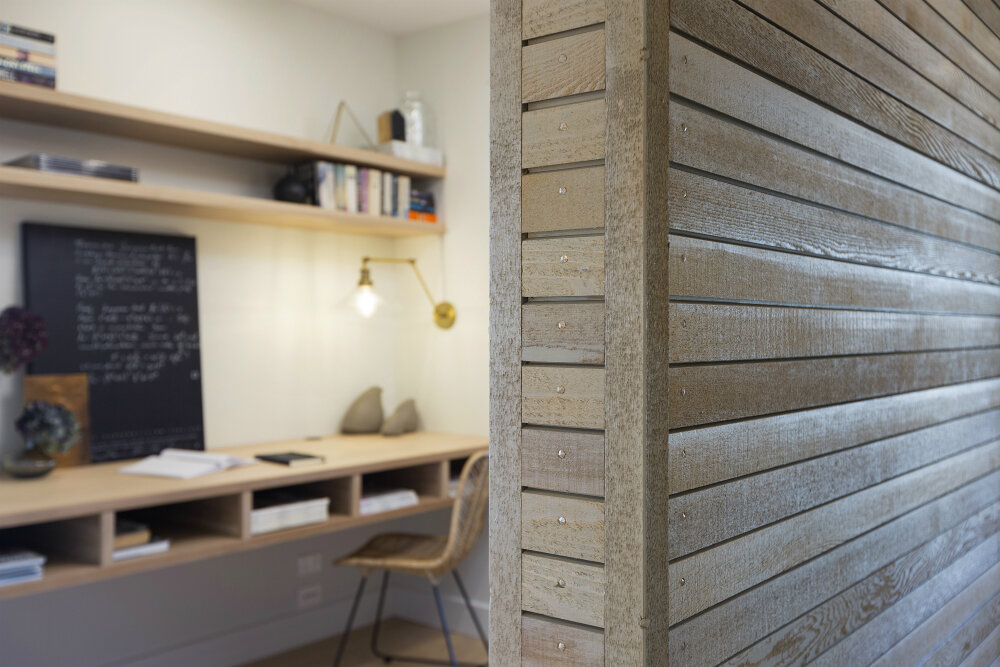Building blocks
If you think concrete is mundane, you’ll need to think again. The Bay’s award-winning builders Gudsell Builders are redefining the artistic possibilities of this overlooked material to create their stunning, acclaimed homes.
If you think concrete is mundane, you’ll need to think again. The Bay’s award-winning builders Gudsell Builders are redefining the artistic possibilities of this overlooked material to create their stunning, acclaimed homes.
words Karl Puschmann | photos Amanda Aitken
Concrete and nature don’t always live in harmony. But Matt Gudsell sees this material completely differently.
He sees the artistic potential and architectural possibility inherent in concrete. As he explains to UNO, his company Gudsell Builders views concrete as a reflective material that’s able to mirror, enhance and blend into the environment it’s used in. Just as long as you have the skills, experience and creativity necessary to do so.
Gudsell Builders has been working with and reimagining the artistic scope of concrete for over four years to award-winning effect. Just last year the company won the Registered Master Builders National House of the Year.
For an example of concrete’s possibilities, Matt highlights the understated elegance of their latest build on Matua’s tree-lined Beach Road. With its stunning waterfront views and sophisticated living, the home is a tranquil retreat from the hustle and bustle of everyday life. With its attention to detail, natural flow and spacious luxury there’s a calming mindfulness.
“The whole idea of this house was to make it look like a pōhutukawa tree because it's surrounded by them,” Matt says of the desirable property. “This house is all black concrete with a pink and red effect. We’ve aged it to get that ruggedness and create that look of bark on the tree. It’s very complex detail and a real showcase of the work that can be done using this system.”
The effect is striking. But like all things that look effortless, a lot of hard work was required to achieve the desirable result. Not only is it an advanced process, it’s also one that demands experimentation away from the site.
“To get this look we trialled different samples, from the materials used to create the pink and the red effect on the concrete to creating the ruggedness and mixed design of the concrete,” Matt says.
“It took us about five trials to get it right before we poured these walls on this house.”
Then he smiles and adds, “But that's the beauty of concrete. The world is your oyster. Whatever you want concrete to look like, we can do it.”
The results speak for themselves, and the many awards Gudsell Builders have collected over the years. Innovative thinking transforms an otherwise overlooked aspect of a build into a graceful and subtle design feature that reinforces the overall design aesthetic and mood of a home.
Returning to this Beach Road home, Matt’s idea was that it would feel like a batch - albeit a luxurious one - that blends in and complements the surrounding pōhutukawas and its seaside environment. This thoughtful design philosophy extends into the home’s interior which has been lovingly crafted in timber with an artisan’s eye for detail to create an ambience of warmth and refinement.
“In my mind, I couldn't be bothered building if I didn't care about the end finish of it,” Matt says. “It's going to be done right the first time, to the highest level of detail and to the highest standards.”
While concrete is not usually considered a glamorous material, Gudsell Builders is challenging that perception as people begin to get their heads around its architectural potential.
“I've got examples I can show people,” Matt laughs when asked if he’s had to sell people on the idea of using concrete as an artistic element of a build. “Once they see examples of what we can do, that convinces them to go ahead. But you have to show them.”
The other benefit of concrete is its unparalleled longevity and hassle-free maintenance.
“It's not going to rot or fall down. It's going to be there for a hundred years. That's what gives people who are looking to build a nice architectural home peace of mind. They’re not going to have to get up and stain the cedar every two years, it’s not going to twist. It's permanent.”
While the process Matt and his team of 15 use to create these desirable results is a trade secret, he does reveal that after experimenting to get the final look, the actual pour is relatively quick.
“We've invested in our own infrastructure. It makes the speed of construction a lot faster. We can also consult with engineers and offer advice on formwork placement and finishes for other builders' jobs,” he says, adding that builders can hire out Gudsell's specialist equipment.
With concrete, the sky really is the limit. He’s excited not only by the design possibilities but also by the thought of what ideas clients may bring to the table.
“If you think of anything that you want to do, it's only a matter of playing around with it and trialling stuff to be able to create that artistic effect,” he says.
Then he smiles and says, “If a client comes to us with some out-there design that they want on their concrete, it’s not a problem. We can do it.”
A touch of glass
Palm Springs meets mid-century modern in this Thorne Group show home.
Palm Springs meets mid-century modern in this Thorne Group show home.
Words Monique Balvert-O’Connor / Photos supplied
There’s much that shines at the latest Thorne Group show home in Papamoa, but there’s one feature that’s an indisputable standout.
Clever design showcases just how the outdoors can be celebrated within the framework of a house. Take a bow, Thorne Group architectural designer Jon McAlpine.
While “indoor-outdoor flow” has become a cliched description, this Palm Springs house is next level in this regard, with an internal garden and many walls of movable glass. There are a total of seven stacker doors, plus a few sliders, that open the house up to its architecturally landscaped gardens. The solar-powered home is a lesson in how it’s possible to both inhabit a building yet reside with nature.
This is evident from the get-go. Of immediate impact upon entering the home is its central atrium garden with a maple tree adding to the Japanese garden ambience. Glass walls surround this garden that’s open to the sky, with the two long walls featuring stacker doors, enabling the house to welcome the outdoors – both the garden and the sky – in.
That’s but the start. The home’s main living area wraps around an outdoor deck (topped by a slatted roof allowing for beautiful, filtered light and airflow.) Thanks to walls of glass, the view from the kitchen island travels over the dining room table to this deck, then through to the lounge and beyond to the expansive kwila deck out back that overlooks a man-made waterway. All these walls of glass are stacker doors, so the house can be opened from the kitchen right through to the deck at the back of the property. The hallway linking the kitchen to the lounge also features stacker doors opening to the covered outside area. There are, in fact, a total of six stacker doors in this main living hub, including one off to the side of the kitchen island where the side garden can be accessed. Along this same wall, the dining room’s built-in window seat languishes below a deep window with panes that also slide right back.
Then there’s the freestanding bath in the en suite, positioned behind, yes – moveable glass – so there’s a sense of bathing outdoors. Raised planter boxes provide privacy in this area facing the man-made waterway.
Given the home’s interconnectivity with nature, it’s little surprise that timber is beautifully showcased, and that Annique Heesen from Gezellig Interiors has ensured natural hues abound in the interior design choices.
Attention-grabbers on the exterior of this single-level home are its curved vertical shiplapped cedar walls, and a boardwalk of timber leading to the front door. The cedar is repeated in various key places indoors. The foyer is an immediate example, with its cedar wall and ceiling creating a seamless connection from exterior to interior spaces. Cedar also features in the main bathroom, on the wall dividing the master bedroom from its en suite, and is the cladding of choice for the outdoor fire surround – the view of which can be enjoyed from all the main living areas.
The cedar happily cohabitates with the home’s eco-friendly cork flooring and wool carpet, and with the many attractive displays of American oak; this timber is used for the kitchen cabinetry, for example, and to frame cavity slider doors featuring beautiful reeded glass.
There’s much to delight throughout this house. The kitchen skylights with automatic rain sensors, for example, or the solar generation with battery storage, or the limestone kitchen island bench, the traditional plaster render in the lounge and on the kitchen splashback and overhead cupboards, and the carport (with great road-side appeal) in lieu of a garage.
The multi-functionality of one of the three double bedrooms also hold appeal. This bedroom features a double bed that folds down from the wall, has its own entry via an external sliding door, and incorporates a dual-access bathroom. It can easily be shut off from the house to form a private visitors’ pad or a workspace. The home does, however, already feature an office. Both the office and a super-sized scullery are sited behind the kitchen’s back wall.
Adding to the overall appeal is the fact the home has been designed to gain 6 Star Homestar accreditation. “Eco-friendly materials and finishes” and “sustainability” have been guiding words in this showhome project. Along with the design itself, all the fixtures, fittings, and materials have been meticulously thought out and calculated to ensure they comply within Homestar guidelines. As expected -- given the many glass walls -- the design optimises passive solar energy, too.
The design brief for this house was Palm Springs with a mid-century modern approach. That box, and so many others, have been ticked. It’s little wonder that word on the street, surrounding this Montiicola Drive address, is that this house will be one to watch out for at architectural awards time.
A private paradise in Pāpāmoa: Barrett Homes owners take us for a tour
When building their own home, Barrett Homes’ Laura and Mike Bryant put their team to work on a custom-designed creation. Laura says it’s a fine example of the company’s skill at creating bespoke homes to suit their clients’ needs.
Laura and Mike from Barrett Homes have built their dream home, and they’re big on doing the same for others.
WORDS Monique Balvert-O’Connor PHOTOS Jahl Marshall
Visit the Barrett Homes office in Pāpāmoa and you’re sure to be impressed with the décor. With timber detail, polished concrete flooring, plush rugs, leather couches, stylish cushions and potted plants, the reception, showroom and boardroom areas resemble spaces you’d see featured in interiors magazines. You may be left with the sense that if the workspace of this bustling business looks this good, the homes must also be pretty amazing – and you’d be right.
When building their own home, Barrett Homes’ Laura and Mike Bryant put their team to work on a custom-designed creation. Laura says it’s a fine demonstration of her team’s passion and skill in bespoke design and builds, an area of the business which they’ve extended to meet the burgeoning market.
“We initially built to the specifications of a removable home with a floating floor, so it could be removed easily in the future and replaced, instead of adding to it or knocking it down,” says Laura. “Having said that, now it’s finished, we love it 100 percent as it is and it isn’t going anywhere!”
The couple and their children Maddie and Beaudie moved into their Pāpāmoa Beach home this time last year after the scheduled 20-week build was completed. The property was previously home to a bach; only the green expanse of a reserve separates it from the water.
“The bach had wooden interior walls and I wanted to keep that vibe, so all the walls and ceilings of our home are plywood,” says Laura. “If you were to take everything out of this house, you’d be left with a wooden box, in the nicest way. It suits my love of natural-themed décor.
This isn’t the typical big house on the beach; we kept it nice and simple inside. It’s really about the view and the different spaces we have created for our family and friends to enjoy.”
As such, the uncomplicated design features a central hallway that connects to three bedrooms (one with an ensuite), a bathroom and an office; the laundry is in the hall, behind a sliding door. At one end of the hallway is a double garage, while at the other, a barn door links to an open-plan kitchen, dining and living area. Accessed by triple stacker doors, an alfresco portico beyond this extends the living area and offers beautiful water views.
Outdoors, the design team came into their own. Every inch has been transformed into an entertainer’s dream , set out into zones. All within 220m2, the family have a bunk room, sauna, spa, a swimming pool, two outside showers, a storage space and a fully equipped pool house – with its full kitchen, pizza oven, dining and lounging area – is well used in the warmer months.
“In summer, it is our home – we live out there. Most people put a separate lounge or extra bedroom in the house, but we did that outside. Part of our bespoke design was to create these separate zones that can be shut off, rather than having all of this in the house.”
Dressing their new home was pure fun, says Laura, who particularly loves how the plants and timber accents pull the natural theme together. Black venetian and roller blinds blend with the black joinery and dark kitchen, while the white benchtop and barn door provide splashes of light. The walls in the bathrooms are covered with floor to ceiling white tiles.
Laura has injected some lovely touches into the children’s bedrooms, such as the whimsical tent bed and canopy. Wardrobe doors aren’t a thing in these rooms; instead, each child has a multi-functional storage space with a hanging rail, drawers and shelves on which to display the likes of Lego collections and other childhood treasures.
“We’ve ensured that our home includes details that specifically suit how we like to live – and that’s the beauty of the Barrett Homes bespoke service,” says Laura. “Whatever the client wants, the client gets.”
Making homeowners happy - one house at a time
With his father in the trade and having pretty much grown up on building sites, it was inevitable that Matt Gudsell would be a builder.
Prepare to upgrade your dream home standards with these incredible Bay of Plenty builds by Gudsell Builders.
WORDS Andy Taylor PHOTOS Amanda Aitken
With his father in the trade and having pretty much grown up on building sites, it was inevitable that Matt Gudsell would be a builder. He farmed for five years, but the tools soon called him back, and that’s a good thing, because Matt has built a solid reputation for creating beautiful homes throughout the Bay of Plenty and Waikato – and for making their owners happy indeed.
“What attracted me to building was seeing the result of all the effort and time that goes into building one of our houses,” says Matt. “I like to see the reward of a job really well done, and that comes down to attention to detail and quality of finish, making sure everything’s just right and to the very highest standard.”
To achieve those standards, at Gudsell Builders, Matt has built a team that shares his keen eye and a passion built on 30 years in the trade. “People are much more discerning now – they know what they want,” says Matt of their customers. “The industry is constantly evolving too. In addition to our team of 24, we have eight apprentices, and the old hands and new guys work hard to keep up to date with the latest technology and products to make sure we offer the very best available. I like to think that what people see in us is dependability and quality, and seeing the job well done is still what I love about what I do – I wouldn’t be doing it if I didn’t.”
The semi-rural resort
Wood, concrete + space
Dependability and quality is certainly what attracted the owners of one of Gudsell Builders’ latest projects in Tauranga’s Bethlehem, for a family of four who were relocating from the Mount and wanted more living space and room to entertain. “Our first experience of building had been great,” says one of the homeowners, “but we were taking our new build to the next level, so we wanted a trusted builder, someone who’d done a lot of quality homes – and Matt had a good reputation for that and for being financially secure.
“Throughout the whole process, we knew that if there was any problem, we could take it to him and he’d take it seriously and fix it. Quality’s very important to him, so if he sees something that isn’t right, he’ll get it fixed, and that’s really important. From a client’s perspective, you don’t always know what to look for, so having his attention to detail was fantastic.”
That shows through in the finished home, which Matt says was a big project with many decorative concrete finishes that took careful setting up to get just right, as well as large decks built for family and friends.
“Gudsell Builders have a great team, which means the whole process flows really well, with plenty of communication,” adds the homeowner. “You hear people saying that they’ll never build again, but we loved the whole process. When you have a partner like Matt, it makes it easy.”
The country retreat
Contemporary cedar luxe
The two-storey home the team built for George Lin and his wife in Te Puna, Tauranga was the couple’s first new build, but they’re already thinking about doing it all again – with Gudsell Builders. The contemporary dwelling with cedar timber throughout is testament to their commitment to quality and communication.
“It was our architect, Brendon Gordon, who recommended Gudsell Builders to us,” says George. “We found Matt and his team really easy to talk to. I really enjoyed the process, so much so that I started thinking that I should build another house! I’ll definitely use Matt and his team again – I wouldn’t change a thing about working with him.”
The beach breeze
A good time all round
Meanwhile, Pete McSweeney’s beachfront Mt Maunganui home merges the Kiwi coastline with thoroughly modern living spaces that champion the tone and texture of stone and timber. Thanks to its carefully crafted open plan, floor-to-ceiling glass and showcasing of materials, it was a design that demanded top-notch craftsmanship and expertise to bring it alive.
“We wanted a modern-day beach house and a builder who could deliver the dream we had and that the architect encapsulated,” says Pete. Gudsell Builders seemed the obvious choice. “I looked at some of the homes they’d built and was really impressed. Gudsell Builders have a great team of people who weren’t just top builders but top blokes as well. Having good banter on site made the process so much easier.”
The evolution build
Glass + light
David and Ainsley Ewings’ impressive property in one of Tauranga’s avenues began as a concept drawing, but in collaboration with their architect and Gudsell Builders, it evolved into something unique. The pavilion-style house features a double-storey living area, vertical shiplap cedar and unobstructed views – and the couple are quick to credit Matt with helping to make it a reality.
“He’s very collaborative, and any issue he saw was flagged well ahead of time so it could be discussed,” says David. “The build went smoothly, even though it was quite a difficult time, with problems with materials being withdrawn meaning we had to consider other options. But we worked on that with Matt and just worked our way through it. I’d recommend Gudsell Builders to anybody.”
“They were such a nice team to work with,” says Ainsley. “Matt is just delightful – and man, did he get the job done. This house is so different, it’s fantastic, so we’re really, really happy.”
A change in the air: how Passive Homes could be the (cosy) future of the way we live
We spoke to architect Brooke Cholmondeley-Smith about his experience with Passive Homes; having built the second ever certified PassivHaus in New Zealand, and living in one himself with his young family.
Whether you live in a new build or an old house, if you live in New Zealand, you’ll probably be familiar with the feeling of chilly toes, the obsolescence of a coat rack (because you never take your coat off), and maybe even whistling door frames or puddles on your windowsills.
As beautiful as our homes often are, the reality of New Zealand’s historical building standards means a nation of houses that are often lacking in performance; a deficit we often feel most keenly in the winter months.
While newer homes and the technologies that come along with them are lifting the bar for warmer, drier abodes, Passive Homes; a concept borrowed from Europe, offer a higher standard of comfort, sustainability and performance that most of us, with our electric blankets and indoor coats, could only dream about.
We spoke to architect Brooke Cholmondeley-Smith of TAWA Architecture about his experience with Passive Homes; having built the second ever certified PassivHaus in New Zealand, and living in one himself with his young family.
How did you become familiar with the concept of Passive Homes?
When I was working in London for an architecture firm I was sent off to Berlin to work for a few months - I got to know some architects there, who were all designing and building to a passive house code. I got an understanding of it, but when I moved back to New Zealand I lost touch with it, it just wasn’t a thing here.
What is a Passive Home?
High-performance homes, such as Passivhaus projects, have specific requirements to meet in order to be called a PassivHaus or Passive Home. These requirements are non-negotiable, and require meticulous planning from the start of the project to make sure all elements work together in the end result. As a structure, it’s a well-insulated and orientated building which makes considerations to regulate the internal environment without little to no need for additional heating sources. It reduces on-going living costs, makes the home comfortable, healthy, quiet, and most amazingly, the perfect temperature all year-round.
How did you come to start building Passive Homes here in New Zealand?
In 2015 I found a course on it in Auckland. It was a really rigorous course, with an international exam at the end. I’d learnt about passive solar when studying to become an architect but we didn’t really look into how the heat leaves the home, so it was that next level of understanding the performance of a home.
Our first Passivhaus project was built in New Zealand in 2011/12. This project was a pioneer for the Waikato region, and the clients were, and still are, passionate ambassadors for this type of housing. The project was well-planned, managed and built but we needed verification, and the best way to do this was to install temperature sensors throughout the home and monitor the performance over several seasons and years.
We were very lucky that the owners of the home played an active part in providing us with extensive data to use and give us a clearer understanding of how Passivhaus worked within the New Zealand climate.
Does building a passive home restrict the design?
Not at all. We design it to a high-performance standard; the walls are built differently, the doors are different from what you’d normally have. But you can design all other aspects as you’d want them. The passive house knowledge is locked into the home at the start and then we can carry on and build a beautiful architectural home from there. We can build them out of any material - we have lots of flexibility around it.
Do you design passive homes as standard?
We build passive home standards into every one of our homes, but there are two outcomes; you can go through the process of becoming certified, get a plaque on your wall and get a mention on the Passive Home website, or you can just enjoy all the benefits without actually having a certified passive home.
How do you test if the house is passive?
One of the ways is to carry out a blower door test. This is an internationally recognised testing system that provides tangible results for the project team to use during the build.
It provides a test result that is universal throughout the world and allows the owners to benchmark their project.
What does it feel like to live in a passive home?
A passive home needs little or no heating or cooling - we aim for the ambient temperature to sit at 20 degrees celsius all year round. We sometimes add a small heater if that particular family wants it to be a little warmer still. We have a passive home ourselves, and it’s unbelievable - we all stay well, we have summer sheets on the bed all year, we’re always in t-shirts and shorts. We couldn’t go back to a normal house now.
It’s much quieter, and you don’t actually know what the day feels like outside. We do have to open the door to see what the day’s like - the kids are in t-shirts and shorts leaving the house for school and have to go back in to get more clothes on! We don’t even wear socks inside - those days are gone. Some people say it’s extreme for New Zealand, but we don’t think so. Living this way is so normal for us now, we forget that it’s not what everyone else is experiencing.
How close are passive homes to becoming the mainstream?
It’s getting there slowly - a lot of our clients are in two groups; people that have immigrated to New Zealand and have built a new home, only to find it incredibly cold to live in! The other biggest group would be older people building their forever home and they want something high-performance that they’re going to be really comfortable in.
About two-thirds of people want to go to the extra expense of their home being certified but most just want us to build all the benefits into the design.
Upstairs for thinking
Registered Master Builder Brent Stewart has never met a construction conundrum he couldn’t develop a savvy solution for.
Registered Master Builder Brent Stewart has never met a construction conundrum he couldn’t develop a savvy solution for.
WORDS Casey Vassallo PHOTOS Salina Galvan
Brent Stewart solves puzzles, but not jigsaw-shaped ones. His puzzles are building-related: tricky sites, leaky homes, renovations and opportunities to add value.
The director of Stewart Construction says, “I love to use property to help people achieve their goals in life. It's always worth taking a few steps back to look at the bigger picture before deciding what to do with your home. If you overcapitalise, you’re soaking up money that could be used elsewhere, like for your child's education, or to fund another property to increase your financial freedom."
The property pictured here presented its own challenges. A steeply sloped site at the end of Wharf Street in Tauranga, it was a feat of engineering to build four high-end apartments here while maximising the magnificent view across the Waikareao Estuary. The result is beautifully finished and feels luxurious. But “We're not any more expensive than anybody else,” says Brent. “We just work really smart.”
Another of Brent’s clients had a three-bedroom home they wanted to renovate and retire in. They felt they needed to pull most of the house down, which saw the cost creeping above their budget, so Brent suggested subdividing, taking the top off the existing dwelling and using it to create one built on piles on the newly created section. The inspiration for that kind of creative thinking came from the success of his own home. He and his wife/business partner Milly had bought an unremarkable property on Marine Parade, and rather than demolish it, he relocated the second storey onto their kiwifruit orchard. The renovation and sale of the orchard and its new home funded the construction of their now award-winning beach house, which has garnered national press.
Brent is originally from Cromwell, and Milly’s from Otorohanga; together they’ve made a home in Tauranga with their children Rocco (12) and Tulsi (9). They started Stewart Construction in 2007. Despite a recession looming, they carved their way through by becoming recladding and leaky-home specialists.
"I hired five people right from the start to support our clients through the increasing number of homes with weathertight issues,” says Brent. “Our team has grown, but I’ve been very careful to make sure everyone’s an expert in their field."
With 23 years of experience, Brent sees the big picture as creating value and capital for his clients. The straight shooter works closely with his foremen Dylan Hone and Johnny Mills and an extensive trade network to deliver each job to the highest standard.
"I’m looking to help my clients add value to their homes by making the right decisions regardless of whether the market goes up, down or sideways,” says Brent. Just las you’d go to a stockbroker or financial advisor for advice on how to maximise your earnings, going to Stewart Construction for property guidance will help you grow the value of the asset that, for most of us, is the biggest we’ll ever own.
“The best time to come to talk to us is before you've started drawing and designing,” says Brent. "That way, we can spot potential solutions before you've invested anything. By thinking bigger than just the four walls of a home and with your best interests at the core, the answer isn't always conventional. I feel really good when I think of the successes our clients have had."
Brent lights up again as he starts to run through some of the ideas he has for the beachfront site he and Milly are about to start building on. Then he’s off to solve another puzzle.
The art of architecture
In-demand architect Camden Cummings talks about his grand designs for homes in the Bay of Plenty.
WORDS DANIEL DUNKLEY / PHOTOS SALINA GALVAN
In-demand architect Camden Cummings talks about his grand designs for homes in the Bay of Plenty.
For Tauranga architect Camden Cummings, designing a home is all about marrying the “pragmatic” with the “poetic”. Sure, a home needs the right number of rooms, a big enough kitchen, and space for your cars, but it also needs somewhere for those moments with the family, a spot to relax and read a book, or a deck to take in the view.
“Architecture isn’t just pragmatics, it’s an art of pulling different elements together,” Cam says. “Good architecture stands apart as it creates special spaces. A home is a container of your memories. It’s where you retreat from the world. You spend so much time there, so you need it to feel special.”
On Marine Parade, Cam has combined the pragmatic and poetic to great effect. A new home on the Mount’s most exclusive street has fellow architects talking, and Cam’s business, Cummings Studio Architects, recently won an NZIA Waikato Bay of Plenty Architecture Award for the split-level property overlooking Mount Maunganui’s main beach.
The award marks a huge early win for Cam’s Tauranga-based company. Before forming his own business, Cam worked for a large national firm behind the concept for the redeveloped Tauranga Airport and Waikato University campus in Tauranga. Out on his own, Cam is keen to add further architectural interest to our cities and suburbs.
An artist and designer at heart, Cam has formulated ideas his entire life. Hailing from Waihi, he initially cut his teeth as a draughtsman, building up skills in technical software and design in New Zealand and Europe. He then spent several years in Australia, studying for a masters in architecture, later working on commercial projects in Melbourne and Brisbane.
After settling in the Bay of Plenty with his wife Peta – an interior designer – and two children, family homes are at the top of his agenda.
“Designing residential homes on a smaller scale is what I love,” he says. “It’s more meaningful working with mums and dads and families. With commercial projects, you’re two or three people removed from the decision-makers. I prefer a closer relationship.”
Cummings Studio Architects was established in 2017, and finished its first award-winning project last year. The grand design, nestled in the heart of Marine Parade, is private enough to feel tucked away from the street, but open enough to view waves crashing towards the beach.
It’s easy to see why the home has earned recognition. The lower floor is split into two sections: a kitchen and dining area with views of the beach, and a “sunken” private lounge. The property strikes the right balance between views and privacy; the front is framed by glass, but occupants in the upstairs bedroom can close things off with timber shutters.
“When we tackled the project, one of the biggest issues was the road,” Cam says. “How could we retain the view of the waterfront, and not make it a fish bowl? For privacy, the bedroom is often at the back of the plan. The client wanted the master bedroom at the front but also wanted to control their privacy. It was a simple solution for them, in the end.”
The Marine Parade house boasts a courtyard between two modern living quarters, and, once inside, people can view the full length of the property. Despite its size, the home doesn’t feel sparse or vacuous, but well-proportioned and warm.
Cam enjoys the challenge of meeting people’s demands, tackling the practicalities, and pairing it with his own creative vision. At the start of each project, clients write a brief and set a budget. Ideas are then pulled together, and cutting-edge technology is used to give clients a glimpse of their creation.
THE PROPERTY STRIKES THE RIGHT BALANCE BETWEEN VIEWS AND PRIVACY
Cam’s practice likes to design the bathrooms and kitchen joinery in his projects, to ensure that design intent is followed through. “These are smaller representations of the larger house, so are equally as important,” Cam says. He pays meticulous attention to detail to ensure cupboards, tiles, bricks and taps match the aesthetic of his design. Only “honest” natural materials are used for the finishing touches. “So many homes look like they’re designed by two different people –I don’t want that,” he adds.
Cam says realising a client’s brief and budget is the most important part of the job. When projects come together, as they have on Marine Parade, a happy homeowner is the most satisfying thing of all, he says.
“One of the nicest things is hearing from the clients at the end. “For me, that’s all it takes – to know they love the house and feel their expectations were exceeded, and that they have a special space to enjoy. As an architect, that’s the biggest compliment you can get.”
Homes we love: a look back over 40 issues
Re-visit some of our favourite homes from the last 40 issues of UNO magazine.
Re-visit some of our favourite homes from the last 40 issues of UNO magazine.
Featured:
Designer: Jorgen Frandsen Location: Otumoetai, Tauranga Issue: 11, summer 2011
The owners needed a home they could work and live in, and one that reflected both the ocean and the industrial nature of the nearby Port of Tauranga.
Designer: Paul Jones Location: Tauriko, Tauranga Issue: 10, spring 2007
The main living areas in this Tauriko home boast a four-metre stud height, expansive polished concrete floors and customised stainless steel fittings.
Designers: Jorgen Frandsen and Nick Chibnall-West Location: The Lakes, Tauranga Issue: 14, spring 2011
Inspiration is taken from the Californian Sea Ranch, and a desire for the dwelling to resemble a series of sheds, with columns like tent poles extending at either end.
Architect: Steven Chambers Location: Tauranga Issue: 28, autumn 2015
This private oasis was conceived as a cluster of differing scaled pods that allow the landscape to ebb and flow around them.
Designer: Ambienti Architects Location: Ōhope Issue: 24, autumn 2014
This bach is nestled into 100-year-old pohutukawas on a hillside, looking out to the ocean at Ōhope. The brief was to recreate the feeling of the old bach which stood in its place: not in design or layout, but in its relationship with setting and the way the family used the home.
Designer: Will Tatton Location: Mt Maunganui Issue: 35, summer 2016
Will Tatton says that his job is a blend of many things: art, psychology and business. “I delve back into dreams and ideas, unpack them, and bring them back to life in a home.”
Designers: Creative Space Architectural Design Location: Coromandel Issue: 32, autumn 2016
Extensive interviewing and planning ensured the owners had a home which will never need to change.
Architect: Steven Chambers Location: Welcome Bay, Tauranga Issue: 6, spring 2006
Perched on a slope in Welcome Bay, this industrial style home rises above the ground and cantilevers out on beams. It looks like it’s floating over the land.
Creating the dream
Good design is a process of elimination. Weigh up the negatives and positives, get the proportions right, and you are well on your way. Where is the best view? Where is there most shelter? Mark Cashmore spends lots of time at the start, looking at every option before designing.
Good design is a process of elimination. Weigh up the negatives and positives, get the proportions right, and you are well on your way. Where is the best view? Where is there most shelter? I spend lots of time at the start, looking at every option before designing.
WORDS MARK CASHMORE / PHOTOS QUINN O’CONNELL
This home in The Mount was a favourite project. I am often asked to design landscapes and swimming pools. But this renovation included altering the interior and the house’s façade. I started the whole landscape concept with a curved line, which ended up as the pool’s edge. The lawn leads to a semi-enclosed pool deck with a spa. It’s rather nice to look back to the house and get away from it all.
THE START OF THE PROJECT: The house had great bones, and sat really well on the property. It was tucked up close to the road, which left a large plot of enclosed, private, north-facing land here at the back.
CLEARING THE SPACE: Under the brolite exterior were weatherboards in fantastic condition, which was an exciting discovery at the start of the project. They de ned the whole beach theme for the house. The entire façade was removed, and the layout recon gured to maximise the north-facing view of The Mount.
Bedrooms were moved upstairs, and the living area moved downstairs
BEACH HOME: The entertainment area is entirely covered by the deck. A pergola extends further, so you can sit outside all year round. Every element has been designed and constructed as a whole: the deck, pergola, the stairs, balustrades and the sail shade. I use expert carpenters to bring these detailed structures to life. It’s designed so that light is maximised where needed, and shade is created to give pockets of cool relief in the summer. All lighting was installed with dimmers to help create atmosphere.
THE CURVE: The whole design of the outdoor area started with a curved line through the section, which ended up being the edge of the pool, the edge of the lawn, and the bottom of a slope. The line could have developed into a wall, or a path, or something entirely di erent. Everything evolved from that line, keeping balanced proportions for the house and land.
DETAILS, MATERIALS, LIGHT AND SHADOW ADD ATMOSPHERE TO EVERY SPACE.
The step, connecting indoors and outdoors, needs to be just the right level for easy transfer of drinks and dinner. It was constructed to give a beachy, boardwalk feel.
This is the crucial view, from inside the house out through the entertaining space, the lawn and the pool. It’s so often spoiled with a fence. By raising the pool slightly and dropping the lawn, there’s no need for one.
A semi-enclosed space for the outdoor shower, with timber detailing to act as a screen.
Get the look with Mark Cashmore
Swimming Pools + Landscapes + Renovations
POOLS NEED TO BE SAFE. But that doesn’t mean you need a fence around it. I use levels, materials, slopes, drops and geometry to design pools that look like water features, feel like part of your landscape, and are perfectly safe and legal.
ACHIEVE YOUR LOOK BY THINKING DIFFERENTLY. I used white pebbles in white concrete as an exposed aggregate for the entertaining area. It reflected light back up into the details of the white pergola and really added to the beach feel.
EVERY PROPERTY AND EVERY CLIENT IS UNIQUE. I will conceptualize the task and develop original design ideas, no matter what size the project. Sketches and lots of communication are important.
44a Tay Street, Mount Maunganui
T. 021 996 300 SWIMMINGPOOLDESIGN.CO.NZ
Boom town
We talk to Shane McConnell of GJ Gardner Homes, Tauranga, about investing in new builds and how to get involved.
We talk to Shane McConnell of GJ Gardner Homes, Tauranga, about investing in new builds and how to get involved.
Jono Sharrock from BNZ and Shane McConnell talk about the Tauranga boom.
PHOTOS JAHL MARSHALL
You may be eligible to borrow up to 90% for a new build, but only up to 80% for an existing house that you will live in, or only 60% if you’re an investor. It’s allowing some people to get into the market, where they couldn’t before and it’s helping to address the shortage of homes.
Before starting, we assess the total cost of completing the build, which includes borrowing costs such as any rent you may need to pay during the build. This all gets capitalised in the loan and is paid for as you incur build costs. That’s why it’s really important to work with a reputable building company that understands time frames and costs.
What’s happening in the market?
Q There have been explosions in the housing market before; why’s this one so special?
Many economists agree on factors affecting the current boom. We have strong immigration into New Zealand, creating a shortage of housing. Increasing numbers of Aucklanders are looking for affordable land to buy and Tauranga is seen as a good solution, particularly with its attractive lifestyle. This has exaggerated the shortage of housing in our region. Add to this low interest rates, favourable government lending criteria for new builds and strong growth in property values and you have all the ingredients for the kind of boom we are experiencing now.
Q I have bought a house, will it reduce drastically in value at some stage?
During the last recession some areas, like Bethlehem, actually increased in value during the recession. Others stayed pretty flat, some areas of The Mount dropped, but overall there wasn’t a big dip. Like most investments, the long-term ones tend to be less risky. It’s risky to take on a mortgage you can only service at low lending rates, as interest rates will inevitably rise again. If you are buying houses to sell them quickly, this too is risky as you need to be selling in a rising market. Always factor in tax implications and realise that at some point the market may dip.
Q Surely it’s not sustainable, this kind of growth. When do you think it will stop?
The Ministry of Business, Innovation and Employment recently released a report predicting the continuing rise in construction in the Waikato and Bay of Plenty, peaking in late 2017 then flattening out over the next four years to similar levels to those seen at the start of this year. Remember, things often get shaken up which are well outside the control of our economy and impossible to predict, such as interesting choices for the next American president which could seriously affect the worldwide economy.
Q Are the new rules with lending going to affect me?
If you are buying a home to live in, generally the new rules shouldn’t affect you. The rules favour new builds, and we use Onion Home Loans and Insurance for our clients. They specialise in brokering construction lending to provide competitive funding packages for new builds. Many of our clients have used this service to access competitive lending terms, and have been given the means to own a new home where it has been previously been denied. As a business, we bank with BNZ, so they also offer great construction lending packages to our clients.
Jono Sharrock from BNZ and Shane McConnell talk about the Tauranga boom.
How do I get into the action?
Q Can I buy a section and sell off a plan?
Yes. Before the title is issued, you pay a deposit of up to 10%. Once issued, you’ll need to pay the rest up front. We have clients who buy a GJ house and land package and put it up for sale before it’s out of council, repeating the same process over and over again. Purely anecdotally, I’d say these clients have done very well! They use us from start to finish for the design, full quote, drawings, selections and sale of their package.
Often, the biggest gains are made by actually building. Once the house is under construction, assess whether it is better to sell the house straight away to release cash for other projects, or wait to extract potentially bigger gains. I suggest you get as much advice as you can from as many sources as possible.
Q Where can I buy a section?
We usually have stock available all over Tauranga: people just like you are still finding great opportunities. Go to gjgardner.co.nz and check our ‘Tauranga listings’. They change frequently with new ones being added, so it’s worth checking regularly or give us a call to find out the latest.
Q Do you have to be registered to buy these packages and build on them?
You must be registered as a New Zealand taxpayer with an IRD number. You can use a trust or a company to buy and sell property. Before getting involved, I suggest you talk to your accountant and lawyer about the best set-up for you.
Q Should I just build the house and sell it, or get someone else to do it?
With the new health and safety laws firmly in place, our responsibility continues long after the build ends. It continues for many years to come. As an individual it is very difficult to find the best quality labour, and if there is a problem with the home during the build or in the future after you’ve sold it, you will be treated as the ‘head contractor’ and legally, the buck stops with you. If you build with us, you get the benefit of our hard-earned reputation, and the quality and value of our established trade and supplier network. You also get an industry-leading, independent, Certified Builders, Halo ten-year guarantee. That is a lot of peace of mind.
A design for life - Will Tatton
We look through some of the ICONIC Mount houses designed by architectural designer Will Tatton, starting with his own.
We look through some of the ICONIC Mount houses designed by architectural designer Will Tatton, starting with his own.
INTERVIEW JENNY RUDD PHOTOS JAHL MARSHALL
“The honest simplicity of a modest all-timber house appeals to me as house construction has become more complex and more processed, more artificial, more everything: ensuites, double garages, automated systems. The list and the costs grow and grow. It’s new builds on steroids.
“Looking for a home for my family, I happened across a ubiquitous 1963 L-shaped, Beazley standard-plan house. What makes it feel so solid, enduring and part of the landscape? This family home is 105 m2 with three bedrooms, one toilet, one basin. The single garage is in original 1963 corrugated steel. What an antidote to today’s expectations.”
Slender, wearing a checked shirt, black woolen blazer, wooden-framed glasses and leather brogues, Will rides his bike everywhere. “We have about ten houses under construction at the moment, and I managed to visit five of them on a bike ride the other day.” He reminds me of a gentle, intelligent, preppy professor at Harvard.
Will Tatton is part of the Bay of Plenty fabric. Of our last two of our covers he says: “Peter Williams is my brother-in-law, and Anne Sharplin is a good friend.
“It’s such a relief, after the recession, to move back to working with the end user. We deal with fewer people now, not so many builders and subcontractors. But that actually makes our job more sociable, and a bit like psychology, which I like.
“My job is a pleasant blend of art and business. The people side of things is eternally fascinating to me. As designers, we work out how people’s lives are going to be led, then we design a house around those patterns.”
PITAU RD, THE MOUNT
The owner’s brother cast the concrete kitchen benches.
“We are all different, but we are all common. In reality, we all have different dreams in our heads, and Kiwis generally feel that they can make those dreams come true with our own house design, whether it’s large or small.
“Over the years, I have developed a way of dissecting people’s lives, working out what their dreams are, what they’ve achieved, and what they’ve accumulated in their brains over years of thinking.
“I often ask clients what kind of materials they liked when they were young, like cedar or stone, what games they used to play, where they’ve been, what they’ve seen and what they loved. All these thoughts collect over many years. I delve back into that psychology, into all those dreams and ideas that are stored in there somewhere. Then I unpack them, and bring them back to life.”
The good life: trading your urban abode for a lifestyle block
Do you dream of trading your urban home for a lifestyle block in the country with pets, chickens, pigs, a vege garden, fresh air and masses of space? Jeremy Pryor provides a snapshot of what rural life is really like.
WORDS LAURA TUCK PHOTOS BRYDIE THOMPSON
Do you dream of trading your urban home for a lifestyle block in the country with pets, chickens, pigs, a vege garden, fresh air and masses of space? Jeremy Pryor provides a snapshot of what rural life is really like.
Many of us would happily trade our noisy neighbours for peace, quiet and a supply of free-range eggs and freshly dug spuds. It’s a lifestyle that fits Jeremy Pryor of Bayleys Tauranga down to the ground. Not only does he sell the rural dream, he lives it too.
UNO: What’s rural living really like?
JEREMY: Most of us have experienced rural living to some degree – maybe you grew up on a farm like I did, or perhaps you had a friend with a cricket pitch on their front lawn. Lifestyle blocks are sought after because they allow you to have a taste of the country without all the hard work, like having to get up at 4am to milk cows. You can still maintain a corporate job, send your kids to the best schools and pop into town with ease.
UNO: How would you define the term ‘lifestyle block’?
JEREMY: There’s no black-and-white answer. I sell a lot of 3000m2 sections in residential lifestyle subdivisions, which are essentially nice homes with big lawns, as well as larger lifestyle blocks with enough land for grazing or an orchard.
UNO: What’s the best thing about living semi-rurally?
JEREMY: It’s fantastic being able to entertain without worrying about the neighbours. It’s also ideal for kids – Ash collects the eggs, Finn feeds the pigs and Charli helps me in the garden. They spend hours riding their bikes, playing basketball and in the pool, which is so much better for them than staring at a screen. We use the shed for storage, the camper and the boat. That’s the beauty of a large section, it allows you to be creative. You’ve also got the option for office space, which is great for the wallet and provides peace of mind for people like tradies, who store their tools at home. The other advantage is the potential for capital gain. If you buy an orchard on the edge of the city that then becomes subdividable, the value of the land can increase fivefold.
UNO: Who’s biting the bullet and going rural?
JEREMY: Lifestyle blocks have always been popular with retired farmers, but today we’re also seeing a lot of homesick Kiwis coming back from overseas who are looking to invest in a slice of clean, green New Zealand land. There’s been a surge in buyers who want to have chooks, plant a vege garden and eat organic produce; I call it the ‘Annabel Langbein effect’. We’ve also had an influx of people from other cities, as they’ve realised they can buy a rural property here for about the same price as an average home in Auckland. When people finally make the move, it can be seen as impulsive because it’s such a big change, but it’s usually been a dream for many years.
UNO: How do you blend a job in the city with a rural lifestyle?
JEREMY: Tauranga is the perfect location in which to enjoy the best of both worlds. My daily drive from Pyes Pa to work only takes 12 minutes on the express route, so traffic is never an issue, but with today’s technology, you could easily work remotely and live the dream. We have great restaurants, shops and schools right on our doorstep. The barter system in the rural community is also alive and well – we get our daily pig scraps from Four14 Espresso café, and in return, I give them fresh bacon.
UNO: Where are some of the best hidden spots for rural living?
JEREMY: Pyes Pa is fantastic, and I’m not just saying that because I live there! With the new Lakes subdivision and Tauranga Crossing shopping centre, there’s huge growth across the whole south-east side of town. Further afield, you’ve got Hawke’s Bay and the Coromandel, both of which are beautiful.
UNO: Your team at Bayleys seems really close – it looks like quite the party with all your families.
JEREMY: Real estate is a 24/7 job, but it’s also highly rewarding. We spend lots of time together, and Craig [Orr], Ike [Unsworth] and I also holiday as a team with our families – it’s the best type of chaos. In summer and winter, when things are a little quieter, I get to enjoy lots of quality time with my wife and kids. We love heading to the bach at Lake Rotoiti and try to get away a couple of times a year.
UNO: Any advice for those considering packing in the city for greener pastures?
JEREMY: It’s about choosing the right type of property for you, so do your research. If you’re after income, there are options with orchards or farms, or for Airbnb; the extra space will ensure your guests aren’t too close to your home, and they’ll pay a premium for a unique setting. But if you simply want more room and don’t mind doing a bit of gardening, the options are endless. Some people outsource maintenance, but I enjoy getting outside and doing the lawns; my ride-on lawnmower has a cupholder, so I can have a cold beer while I work!
House proud: Landmark Homes latest show home brings the wow factor to Omokoroa
Carly Stewart suspects the latest Landmark Homes Bay of Plenty show home in Omokoroa may forever be her favourite. She and her husband, Logan own the franchise and have recently opened their latest creation, which brings a whole lot of wow factor.
Its creators and its visitors are getting a real kick out of this stellar new Omokoroa show home.
WORDS Monique Balvert-O’Connor PHOTOS Amanda Aitken
Carly Stewart suspects the latest Landmark Homes Bay of Plenty show home in Omokoroa may forever be her favourite. She and her husband, Logan, own the franchise and have recently opened their latest creation, which is drawing all kinds of favourable comments.
Sitting high with water views, the new 244m2 show home has a suitably coastal aesthetic. It’s a celebration of white well done. “It’s quite a different style to our first one in Edgecumbe Road, Tauranga,” says Carly. “It’s traditional in the sense that it’s a linear weatherboard home, but contemporary due to its fresh Hamptons-with-a-Kiwi-twist look. Think white, white, white, from the roof to the exterior and interior paint colours, to the curtains, to the kitchen…”
The two-storey house has roadside appeal by the bucketload, tempting you to explore. A long, extra-wide hallway leads from the entryway to the main living area. There’s a true sense of arrival when entering through the French doors into this space complete with a tongue-and-groove cathedral ceiling. With its exposed rafters, this pitched feature continues out to a portico. On offer here is covered seating, Kaimai views, an outdoor oven and a fire (there’s an inside fire too). A snug/media room, two bedrooms, a powder room, a bathroom and the laundry can all be found on this level of the house, with the generous garage a few steps down.
Upstairs is dedicated to the master suite. Carly loves the “pure luxe” ensuite with
its glamorous back-lit mirrors and free-standing bath. For her, dressing houses is a way to express her creative side, and the light fittings used this home are a fine example of her flair. Brass lantern-look exterior lights hint at the nautical, while immediately beyond the front door are rattan-style drop pendant lights hung at staggered heights. A beaded handelier is an eye-catcher in the dining area, and in the powder room and master bedroom suspended lights are examples of the “subtle, special touches” Carly loves to inject.
Also wonderful are the brushed- brass accents throughout, such as the ensuite tapware and handles on the main living area’s double doors.
This house has true multi-generational appeal. There are a number of built-in technological features that ensure it’s future-proofed – and there’s even provision for a lift.
To be wowed by this beautiful show home, call into 2 Goldstone Place, Harbour Ridge, Omokoroa. It’s open Tuesday to Sunday from noon until 4pm, and by appointment.
Designer family
Thorne Group’s Lisa Thorne discusses the merits of working together as a family, and how they do what they do so well.
Directors Gavin Morrow, Peter Buck and Aaron Thorne.
Having dinner with other couples who also work together, one of the wives told us about an article she’d read detailing the perils of family businesses. It can seem, from the outside, to be a minefield.
WORDS LISA THORNE PHOTOS AMANDA AITKEN / QUINN O’CONNELL
Zak, our quantity surveyor, told me last week that he didn’t ever want to get married based on seeing Pete and I at work! However one of the secrets to making it work, is that we just don’t take our work conversations home. That way, all the fun bits of family life stay intact, as does our marriage.
Our discussions round the dinner table gave me plenty to think about. It made me examine why working together works so well. New Zealanders are particularly fond of working with their families and self-reflection is always a healthy thing, so I have compiled my own thoughts on why it works so well.
Four Reasons Working with My Family Works
1. Our customers get exactly what they want. And more, because every home we design and build carries our family name. That family brand is the best guarantee on the market. We are fastidious about quality. We always encourage people to chat with previous clients, because we know they will recommend us in a heartbeat. We have one project manager and one lead builder working on each home (surprisingly it’s not that common). And we would never compromise on quality to take on more clients.
2. Our family say it like it is! Designing and building someone’s home, the single biggest financial commitment they will ever make, is stressful. Those stresses create niggles and frustrations with each other. Being family, we say things to each other which would, in other working environments, remain unsaid. The air is cleared, and we move forward without resentment. That said, some of our younger team members are learning about some aspects of marriage they’d rather not, hence our quantity surveyor declaring his bachelorhood evermore.
3. I work with the best people. At the end of the week, we get to kick back, drink beer, play darts and re-cap on all the action. There’s plenty of fun to be had amongst the professionalism. In fact, Pete often jokes our atmosphere is more IT start-up than traditional designer/builder company.
4. We trust each other. Everyone in our business is so incredible at what they do, we don’t have any crossovers of roles and just get on with playing to our strengths.
Lisa Thorne, marketing manager.
This is how it works:
Pete is the planning and details man with a background in corporate banking. He’s a total perfectionist. That’s great for our clients, but not so much for me as the creative cog in our wheel. I have lost count of the number of times I have been reprimanded for spelling mistakes or ‘creative’ budget spends.
Aaron and Gavin are the practical ones. In fact I always laugh when people ask if Pete is a builder. Aaron and Gavin wouldn’t let him near a hammer! Gavin wouldn’t admit it but he is a secret geek when it comes to building. He will often be up till midnight studying highly complex plans to ensure everything is millimetre perfect.
And as much as I hate to admit it to him, my brother Aaron is an amazing project manager. We use arguably the best technology in the world. Each of our clients gets their own, secure website detailing their project, Aaron’s regular reports, photos, consents, everything.
Jon is the newest member of our family, as the director of Thorne Group Architecture. We welcomed him officially into the fold a couple of years ago. It made perfect sense to expand our business to Thorne Group: Design and Build Experts. All under one roof we can design your home, or build it, or both. The energy and experience Jon breathes into the architectural arm of our business is, frankly, second to none, and he is equally talented at designing any size of house, large or small.
Five design features most likely to add capital value to your home
If there’s one aspect to our job which unites us all at the Thorne Group, it’s our love of design. Jon designs everything from opulent, beachfront mansions to small, smartly thought-out homes. He has learnt a thing or two in his career, and shares a few insights with you here in some of the homes Jon and his team have designed.
1. Covered outdoor area: This isn’t just about providing shade on a summery day. With detailed planning and clever design taking into account privacy, views, prevailing winds and sun angles, a covered outdoor area can be functional even on the coldest winter’s day.
2. Flexible spaces: Lots of people specify ‘open plan’ on their brief, but we find that flexible spaces work better. For example, a large feature door between the kitchen/dining and living areas serves as a removable wall. Slide it closed to separate noisy children while you enjoy a glass of wine with your friends, or open it up to create a sense of space. Your need for space changes as your family develops. Lisa has told me of the dream house she moved into some years ago, which had two large living rooms connected by a corridor. Her then little children clung to her ankles while the second living room gathered dust.
3. Study nook: Another item people often write on the brief is a separate study. We have found study nooks to be a better option; electronic devices are so portable, a separate room isn’t necessary. It’s great to put the children there with homework, keeps you connected to warmth and the action of the house, and best of all, saves on floor area and therefore costs, freeing up budget for other areas.
4. Window seat: Placed correctly, a window seat can perform many functions; in this home it is integrated near the kitchen, so that when the living room is closed off, it immediately creates another entertaining zone, for people to sit and chat while your chef creates magic in the kitchen. Floor space does not need to be increased to accommodate the window seat, and you can use it for more storage too.
5. Feature ceilings: Use your ceiling as a canvas to create feeling. The trusses in this photo may may look simple, but as we often say at The Thorne Group, the devil is in the detail. The structure looks incredibly neat, belying the huge amount of engineering, physics and millimetre precise execution behind it. The result is a feeling of extra volume to the room beneath. A perfect example of using a ceiling as a feature.
20 years in the making
The foundations for Thorne Group were laid over 20 years ago by well-known land developer Bob Thorne.
The business was growing in scale by the time daughter Lisa and her husband Pete returned from corporate roles in Sydney and London. Bob’s son Aaron, a project manager, joined forces with Pete and qualified builder, Gavin Morrow and in 2007 officially set up the Thorne Group.
Designing and building small and large homes as well as everything in between, the Thorne Group are now the Bay’s biggest family-owned building and architectural design company







